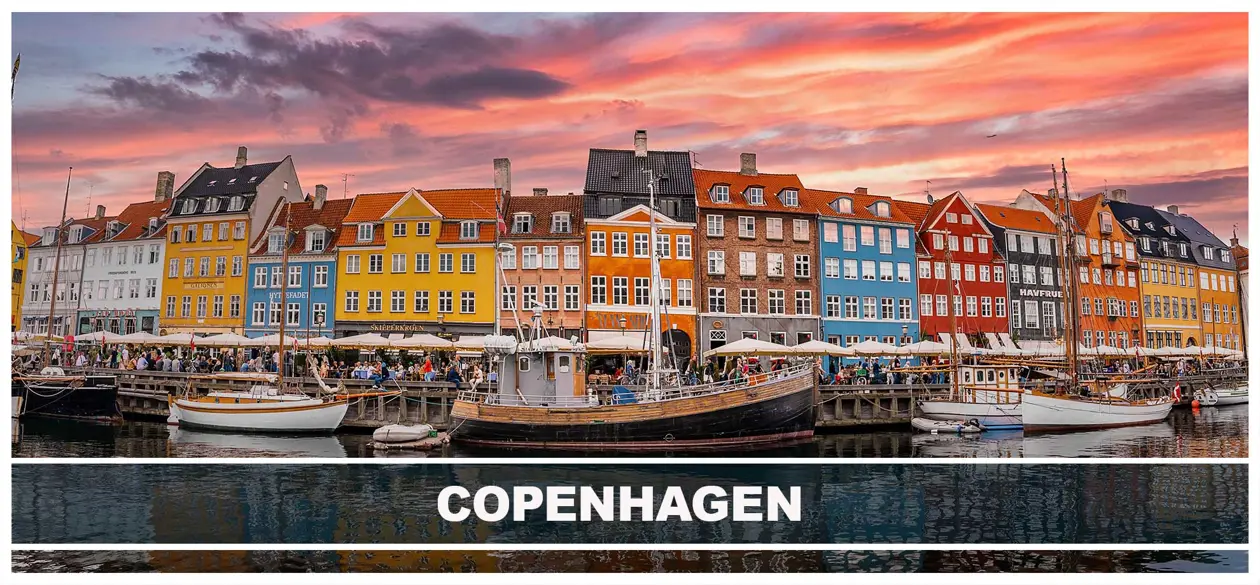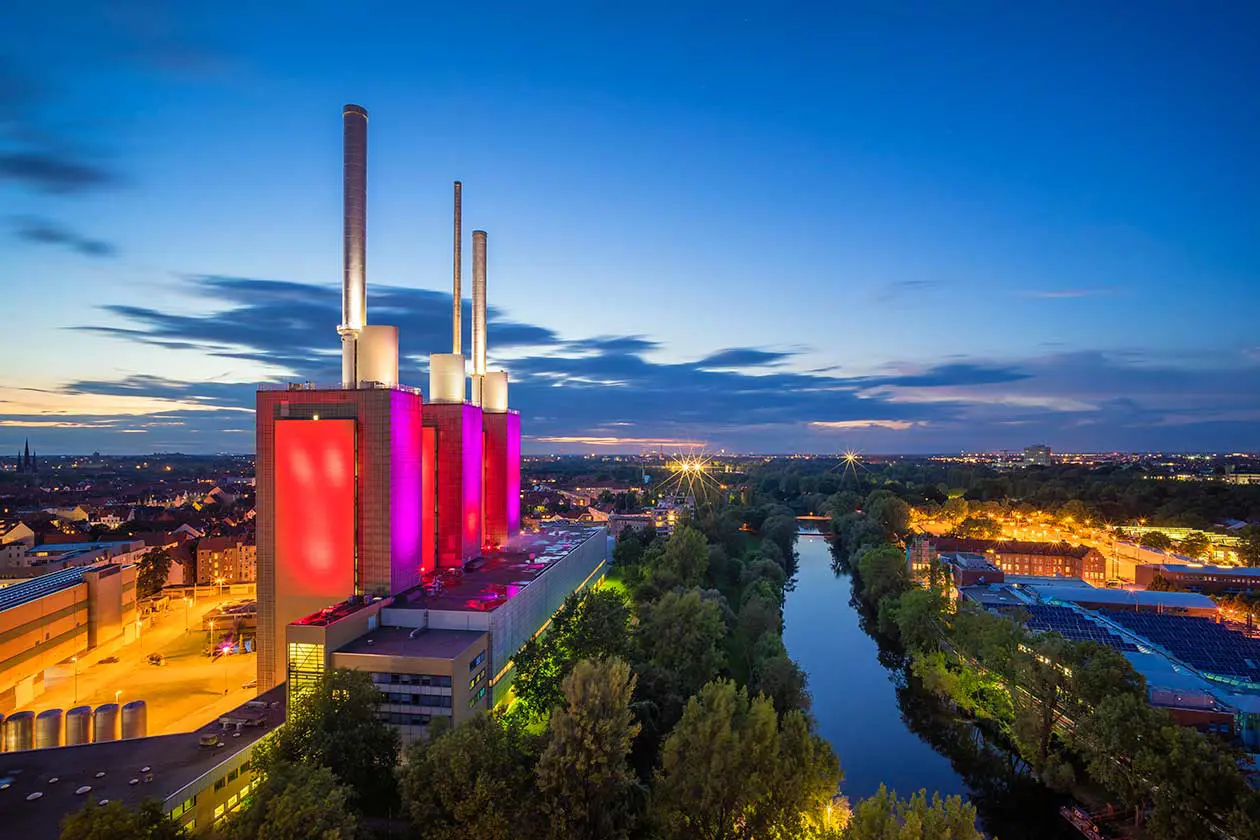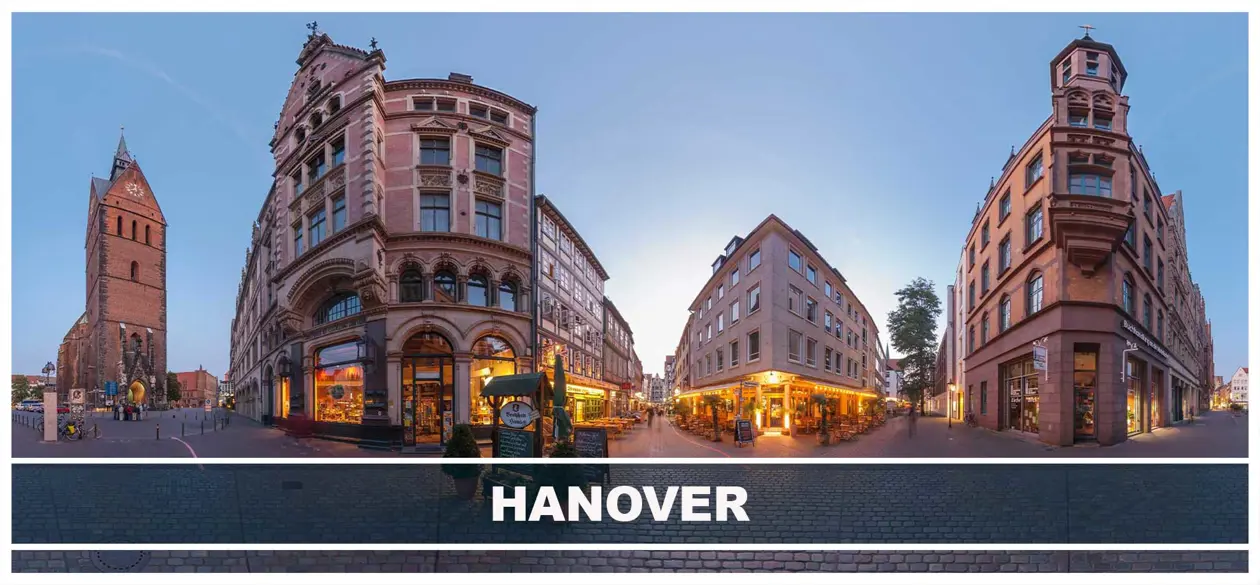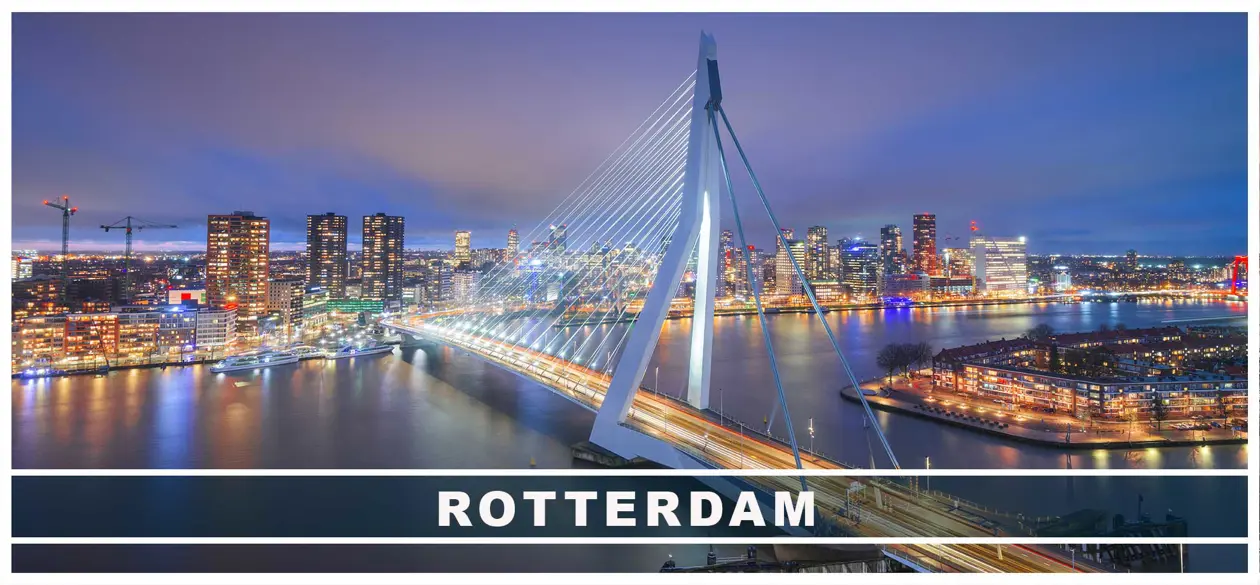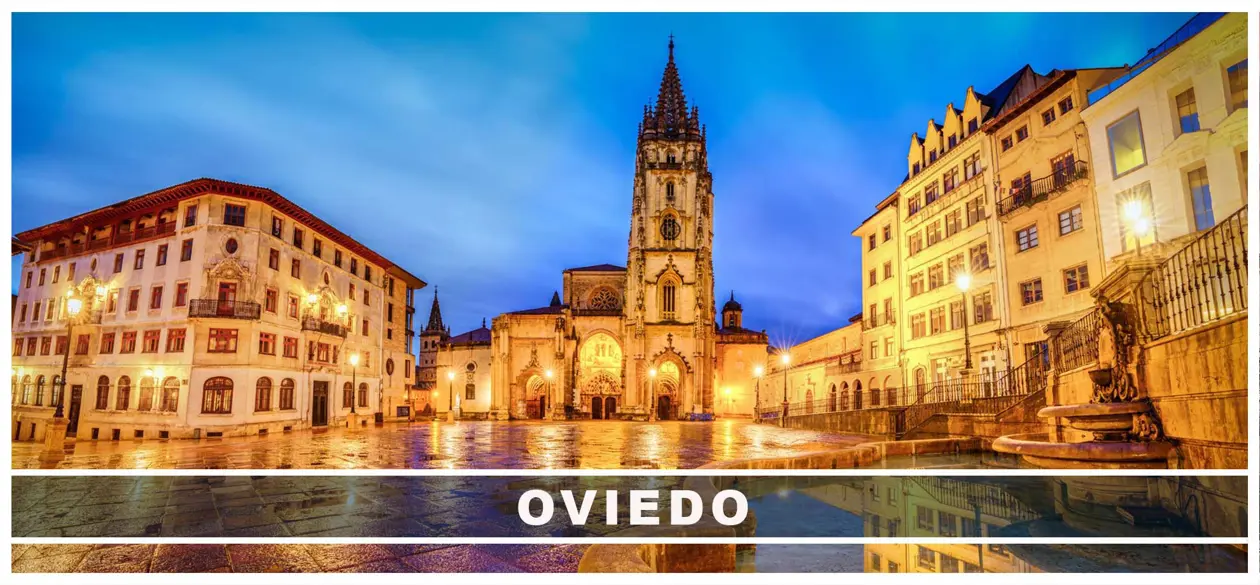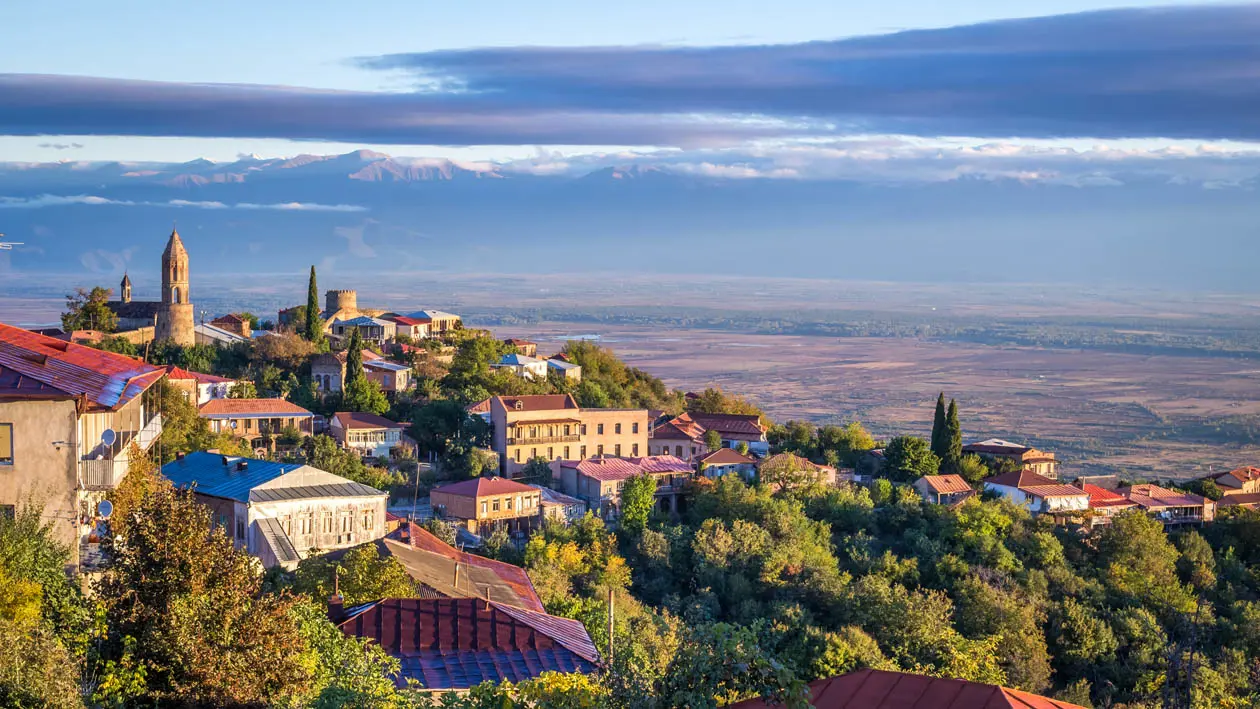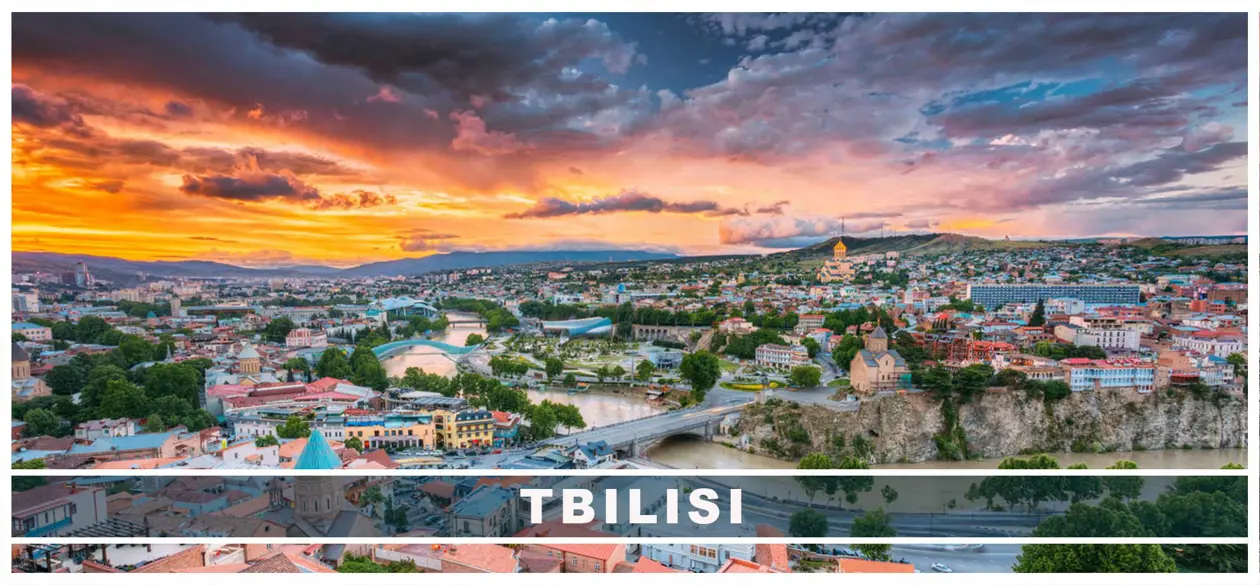Advertising
COPENHAGEN QUEEN OF THE BICYCLE
The green revolution of the Danish capital: where bicycles reign supreme
Text by Alisè Vitri
Copenhagen stands as one of the most bicycle-friendly cities in the world. Known as the “City on Bikes”, it is tailored for cyclists with 546 km of separate bike lanes, car-free bicycle bridges, bike parking, and innovative architectural solutions. These features led to Copenhagen being named the World Capital of Architecture in 2023, marking it as a pioneer in sustainable urban design focused on people's well-being.
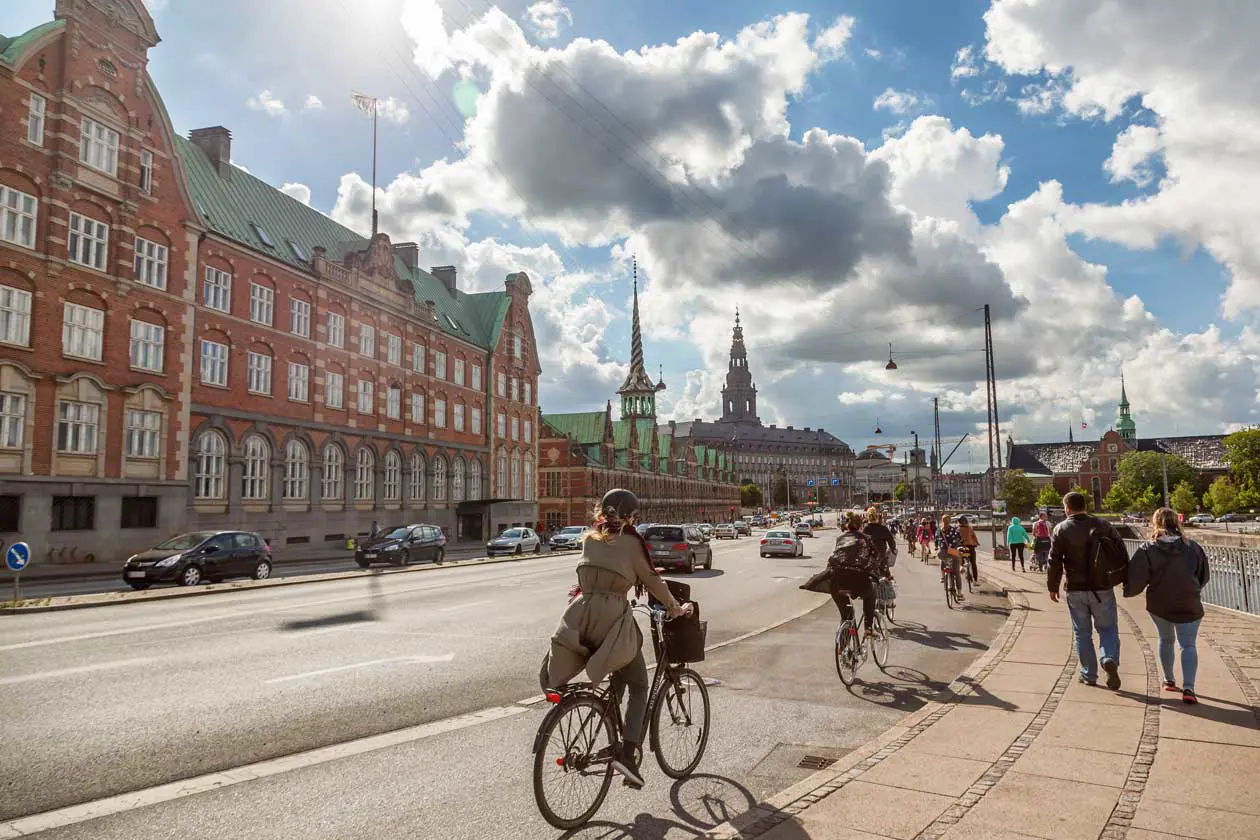
Copenhagen by bike. Photo: Copyright © Sisterscom.com / Depositphotos
This achievement comes after years of targeted urban and architectural choices. In Copenhagen, cycling infrastructure and architecture promote a healthy and sustainable lifestyle where bicycles outnumber cars, and people prefer cycling over driving, whether it's on a classic bike, road bike, cargo bike, children's bike, or electric e-bike.
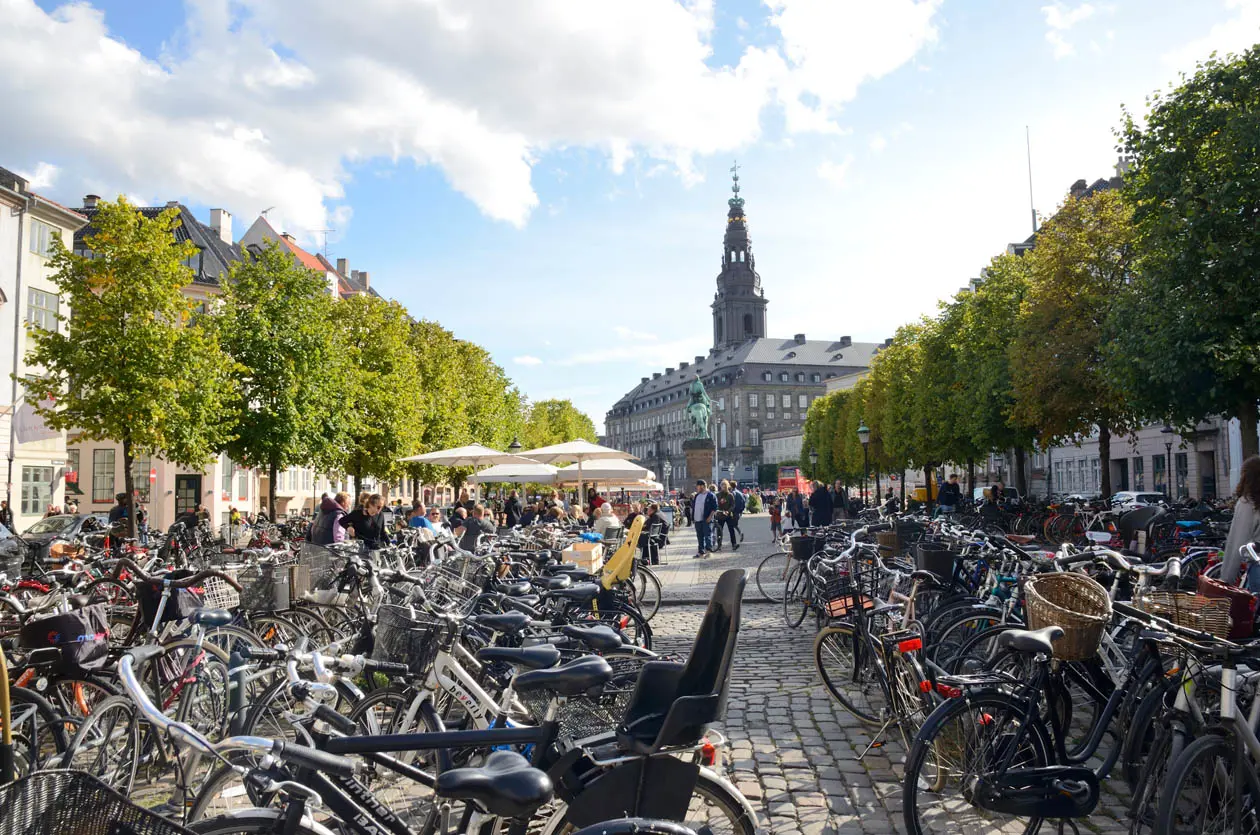
Copenhagen by bike. Photo: Copyright © Sisterscom.com / Depositphotos
For tourists visiting the city, cycling is an excellent way to explore Denmark's capital and experience the local culture just like a resident, easily moving between different neighborhoods on bike paths and crossing, for example, bicycle bridges that offer beautiful views of the harbor and maritime life.
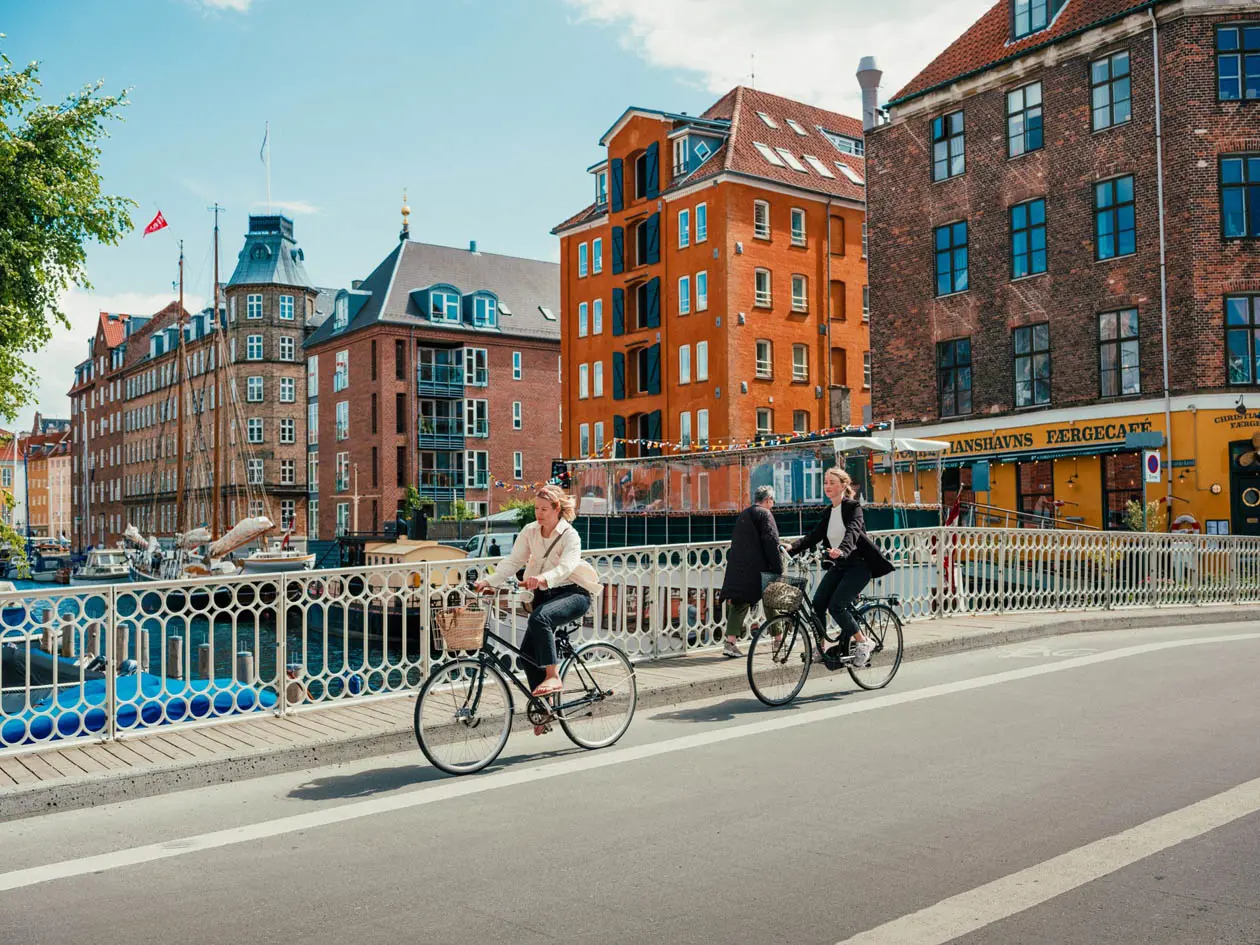
Copenhagen by bike. Photo: Copyright © Visit Copenaghen
Copenhagen's cycle bridges
These bridges connect well-known bike paths and are heavily used by both locals and tourists, providing a scenic view of the city on two wheels. For instance, the city's newest bicycle and pedestrian bridge, Lille Langebro, was completed in 2019 by Wilkinson Eyre Architects. It connects the contemporary harbor area around the Blox zone with the historic harbor of Christianshavn, accessible from the city center and vice versa. This 160-meter bridge links one of Copenhagen's most picturesque neighborhoods, Christianshavn, to the city center with a modern and elegant design. The swing bridge features “wings” that open in the middle to allow boats to pass. For cyclists and pedestrians, this bridge offers an excellent alternative to its busier sibling, Langebro.
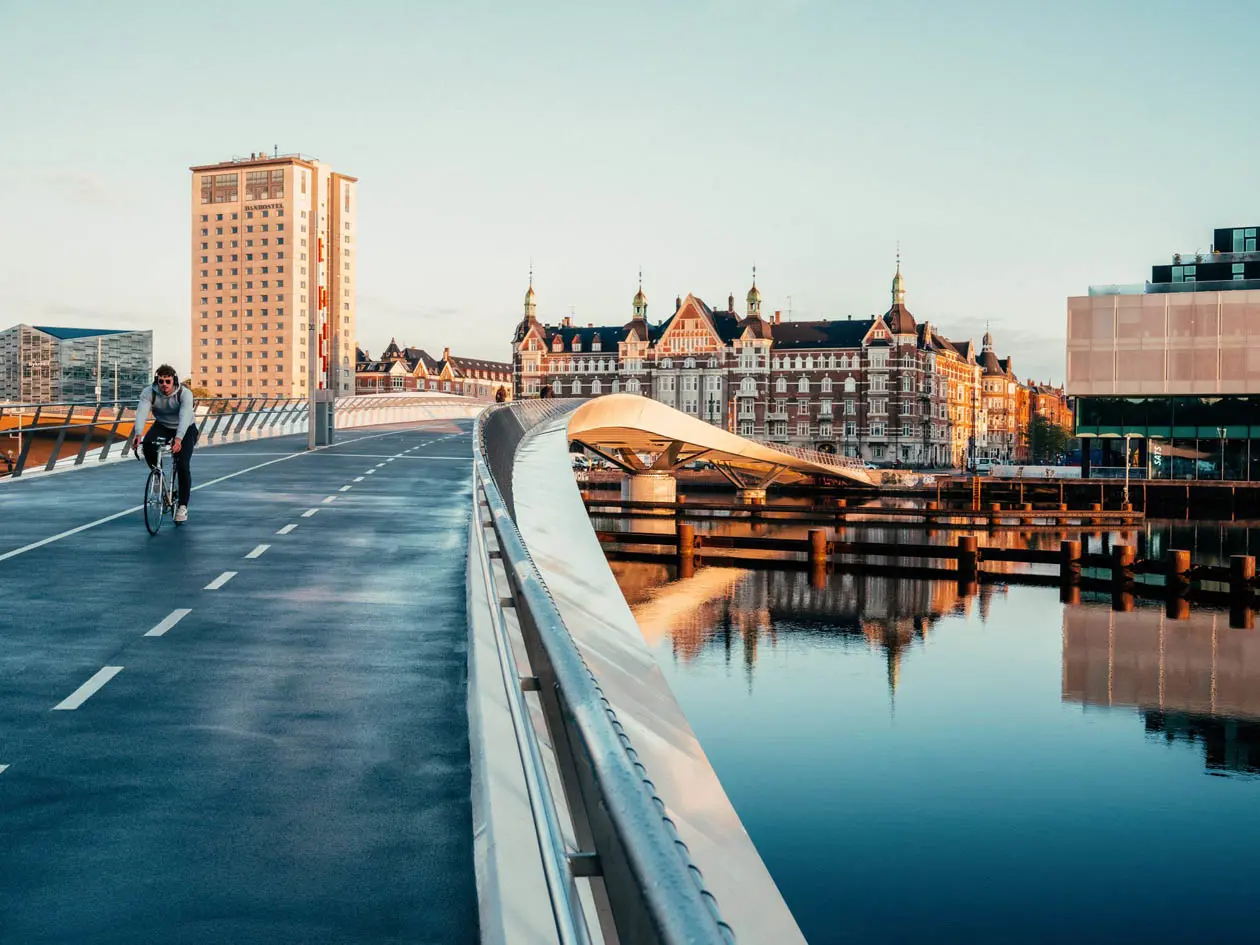
The Lille Langebro cycle bridge in Copenhagen. Photo: Copyright © Visit Copenaghen
The Circle Bridge, completed in 2015 by architect Olafur Eliasson, features five masts and five circular platforms. It is favored by pedestrians as a panoramic spot for meeting, pausing, and enjoying the harbor and waterfront views. And when large ships need to pass, it opens like a gate, allowing access to Christianshavn's canals.
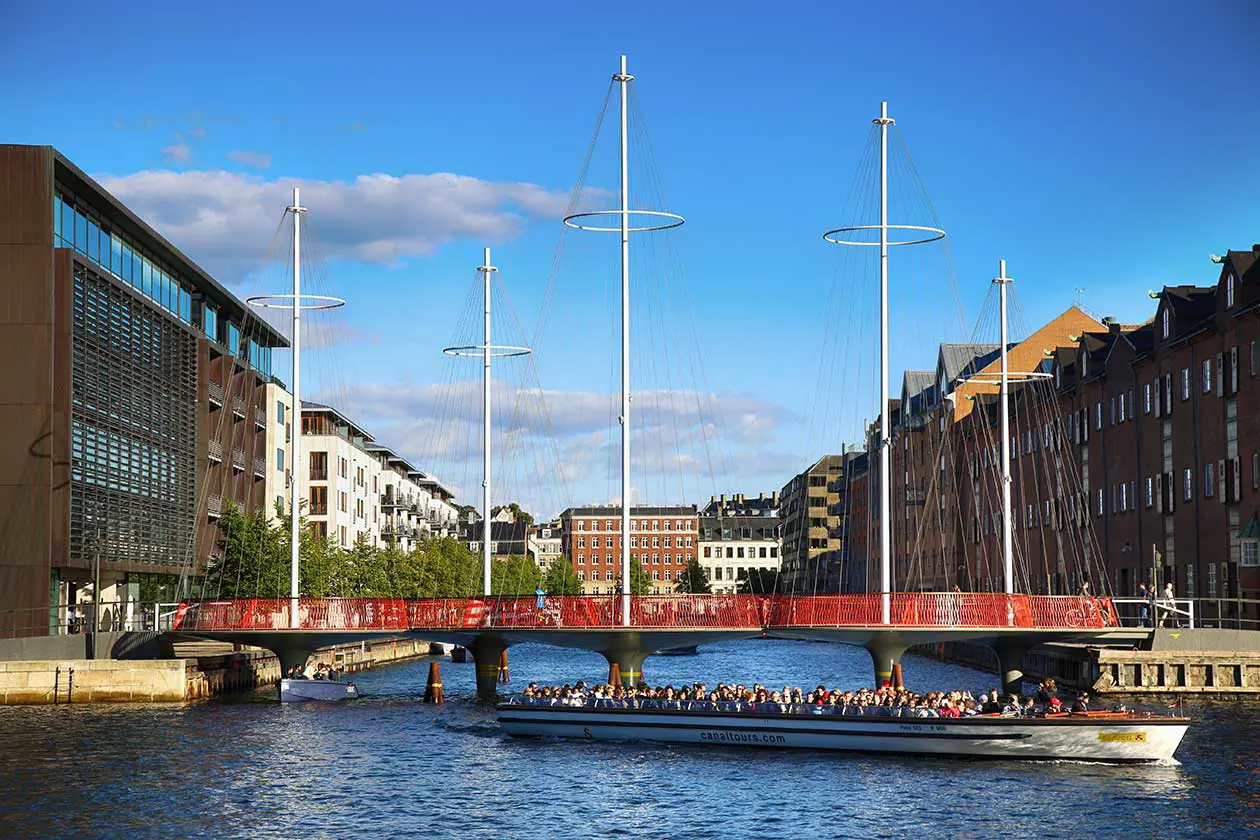
Circle Bridge of Copenhagen Photo: Copyright © Sisterscom.com / Depositphotos
Meanwhile, the trendy Nørrebro district in Copenhagen is encircled by a floating pedestrian and bicycle path that zigs and zags. It is a winding path that follows the organic shape of the Mærsk Tower building (completed in 2017 by C.F. Møller Architects), offering overhead views of nearby green spaces and city rooftops. Bicycles can be parked in the basement, and visitors can head to the 15th floor to enjoy incredible city views from a tower open to the public.
The Bicycle Snake, completed in 2016 by Dissing+Weitling, is an elegant, sinuous orange bicycle bridge and path that eliminates the need for cyclists to go up and down stairs from Dybbelsbrø to the harbor. A raised path for cyclists, it plunges and winds seven meters from the upper road to the lower, offering a fun riding experience. It connects with another bicycle bridge across the harbor, Bryggebroen, making cycling in this area seamless.
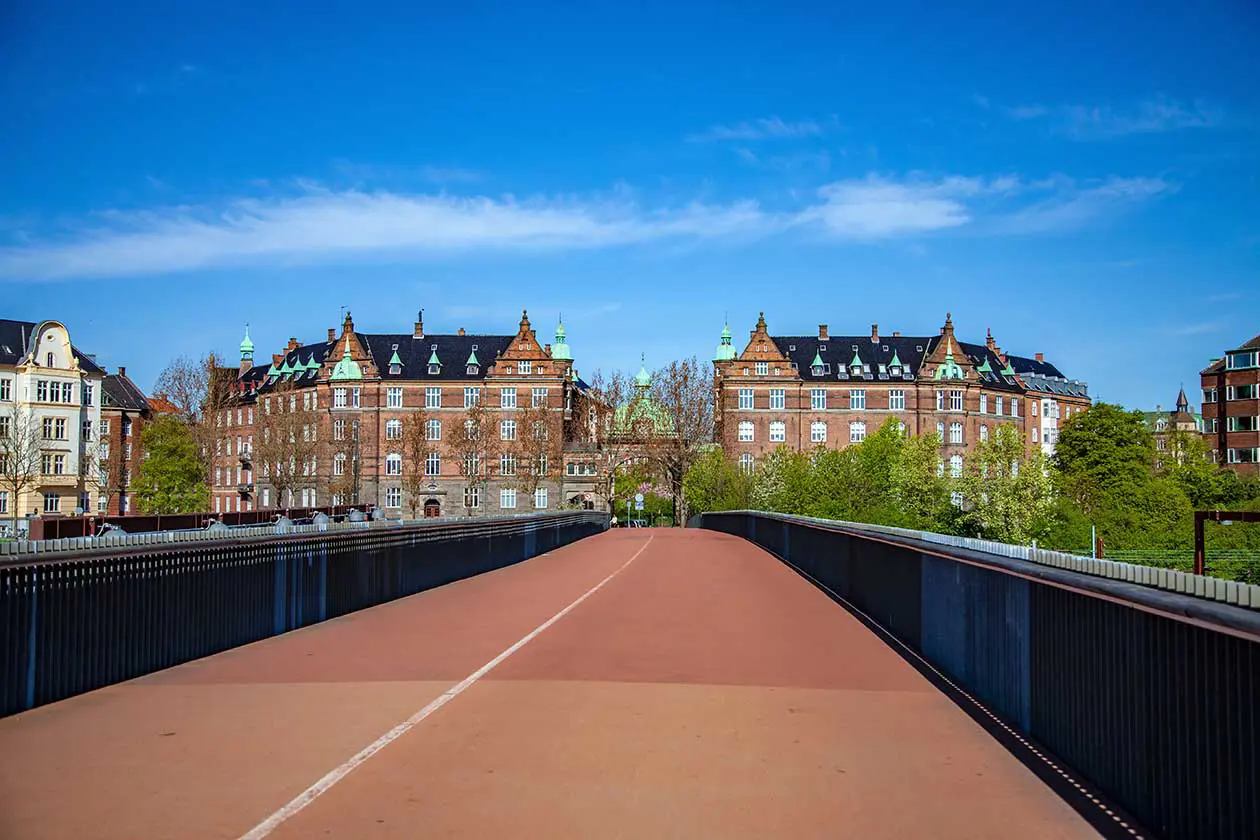
Bicycle Snake of Copenhagen Photo: Copyright © Visit Copenaghen
The Alfred Nobel Bridge, completed in 2018 by Cobe architects, is located south of Copenhagen and is part of the Harbour Circle, a 13 km bicycle path around the inner harbor. It is known for its 70-meter-long wooden bench, offering views of the floating homes and harbor life. Here, people stop to enjoy the view, also using it as a meeting and evening entertainment spot.
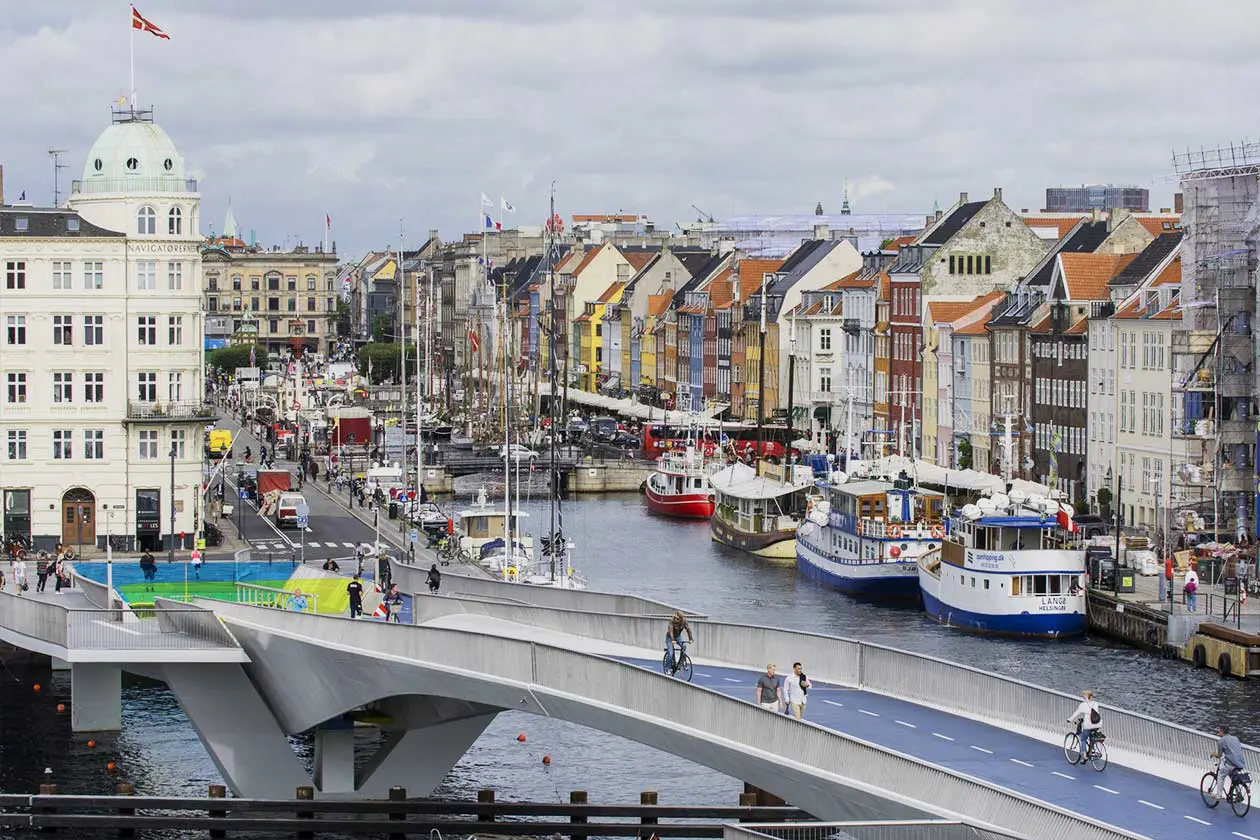
Copenhagen by bike. Photo: Copyright © Visit Copenaghen
Copenhagen’s bicycle paths
Copenhagen is truly a paradise for bicycle lovers, offering a unique and eco-friendly way to discover its charming streets and picturesque urban landscapes. Upon arrival, one can rent a bike independently, even directly from hotels, or choose one of the bicycle tours to safely explore the city and its architecture on two wheels along bike paths and wide avenues with only a few precautions in mind: rent a comfortable bike, use a lock, signal before turning, and watch for traffic lights.
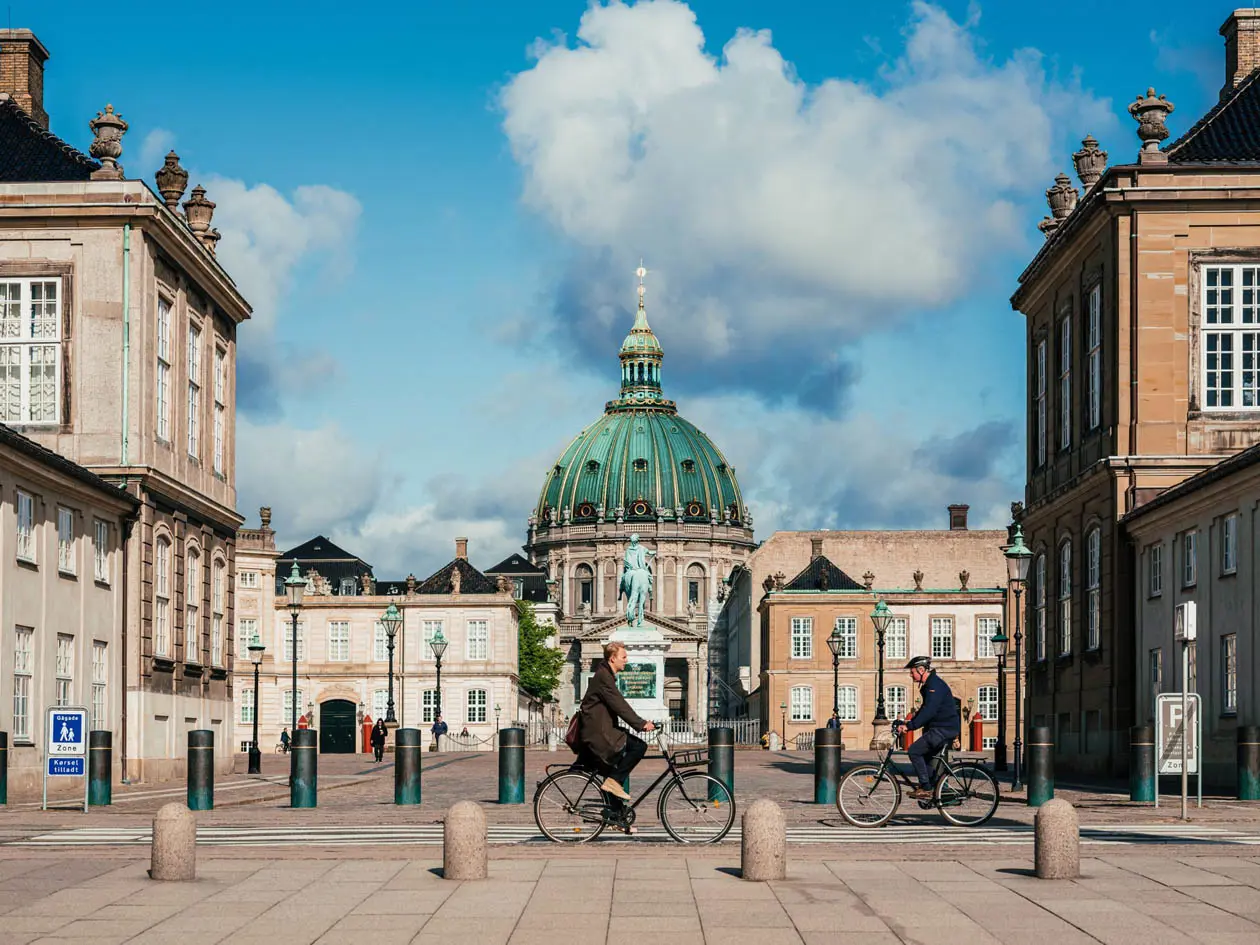
Copenhagen by bike. Photo: Copyright © Sisterscom.com / Depositphotos
More avid cyclists can take the Green Bicycle Lane, a 57 km green bike path that crosses the entire city. But to see the city highlights, just 2 or 3 hours on an electric or traditional bike is sufficient. Start by cycling on the bike path offering breathtaking views of the harbor and the colorful buildings of Nyhavn with a stop at Tivoli Gardens, one of the oldest amusement parks in the world. Continue to the famous Little Mermaid statue on a rock along the seaside promenade, one of Copenhagen's icons. Then pedal to the Christiania district, known for its colorful street art, a perfect area for peaceful biking while exploring unique markets and local cafes.
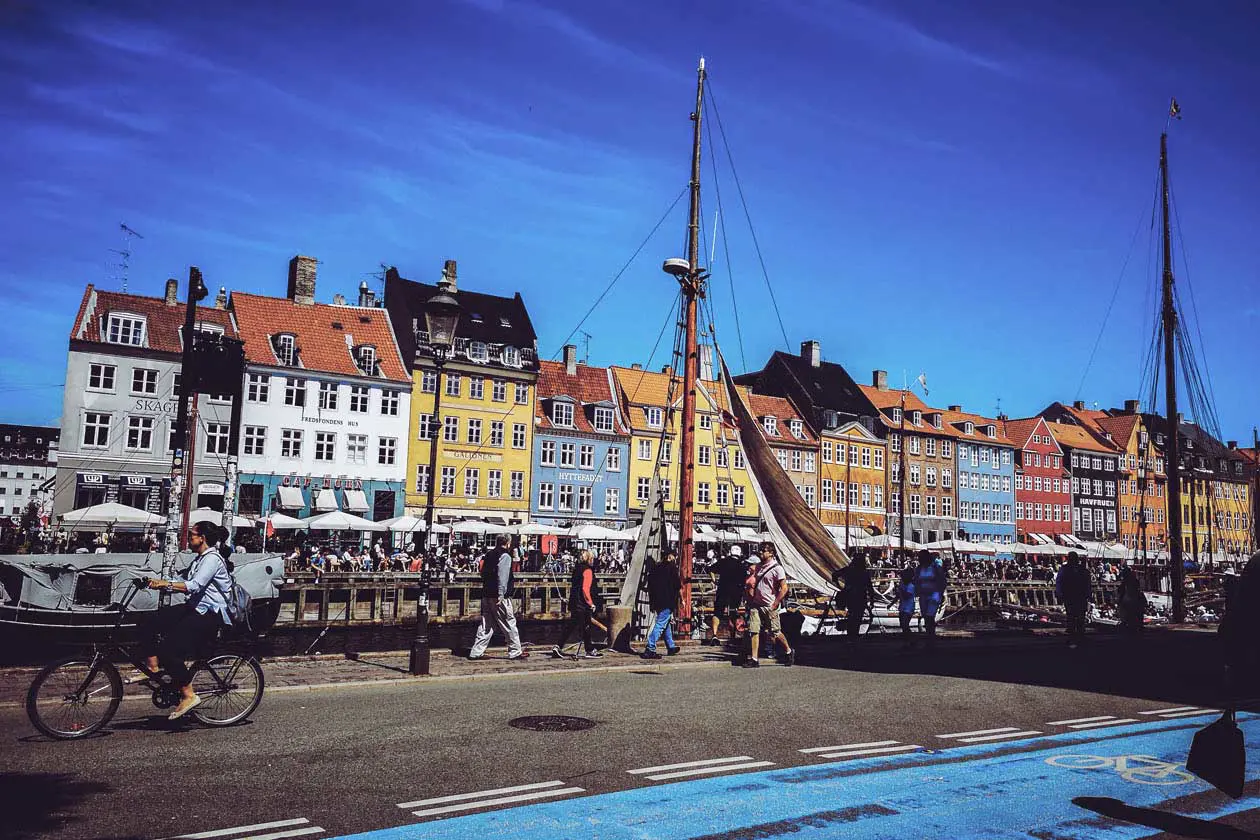
Copenhagen by bike. Photo: Copyright © Sisterscom.com / Depositphotos
If there's more time, extend the bike tour to include other gems such as Rosenborg Castle, a majestic Renaissance-style palace set in the King’s Garden (Kongens Have). Then, the Round Tower (Rundetaarn) for a panoramic view of the city from the old astronomical observatory with a ramp that winds to the top without stairs. Stop for a snack at Torvehallerne, a vibrant food market where you can taste local specialties like smørrebrød (Danish sandwiches), fresh pastries, and craft coffee. Continue to Amalienborg, the Danish royal family's residence, and finish the tour with a visit to the Black Diamond, a modern part of the Royal Library of Copenhagen on the waterfront, known for its extraordinary black glass facade and art and culture exhibitions.
|
Copenhagen Photo: Copyright © Sisterscom.com / depositphotos
Tradition, elegance, and modernity are fully embraced in Copenhagen. Far from the chaos of major capitals yet extremely captivating, it is a city that is delightful to explore. It is renowned for its modern architecture and innovative design. Its buildings harmoniously blend tradition and modernity, featuring many works by renowned architects like Bjarke Ingels.
|
|
Advertising
Tours and excursions in Copenhagen
GetYourGuide is an online platform that offers bookings for tourist experiences around the world. You can have unforgettable adventures while soaking in the beauty of Copenhagen. For example, among the various tours and excursions, you can choose a 1.5-hour bike tour to discover Copenhagen, a boat cruise in Copenhagen, or even a culinary tour in Copenhagen. It's an original way to get to know the city better.
|
CITY BREAK IN HANOVER
Art, culture, and entertainment in the vibrant capital of Lower Saxony
Text by Enzo Cuppatri
Hanover captivates with its history, culture, and charm in the heart of Northern Germany. A fascinating destination, it offers a vibrant mix of tradition and modernity, with a wide range of tourist attractions for every type of traveler.
The city welcomes visitors with historic squares, majestic buildings, enchanting gardens, and intriguing museums, promising an unforgettable experience for a city break. Even with limited time, you can visit the best of the city by dividing your day with stops at the must-see attractions.
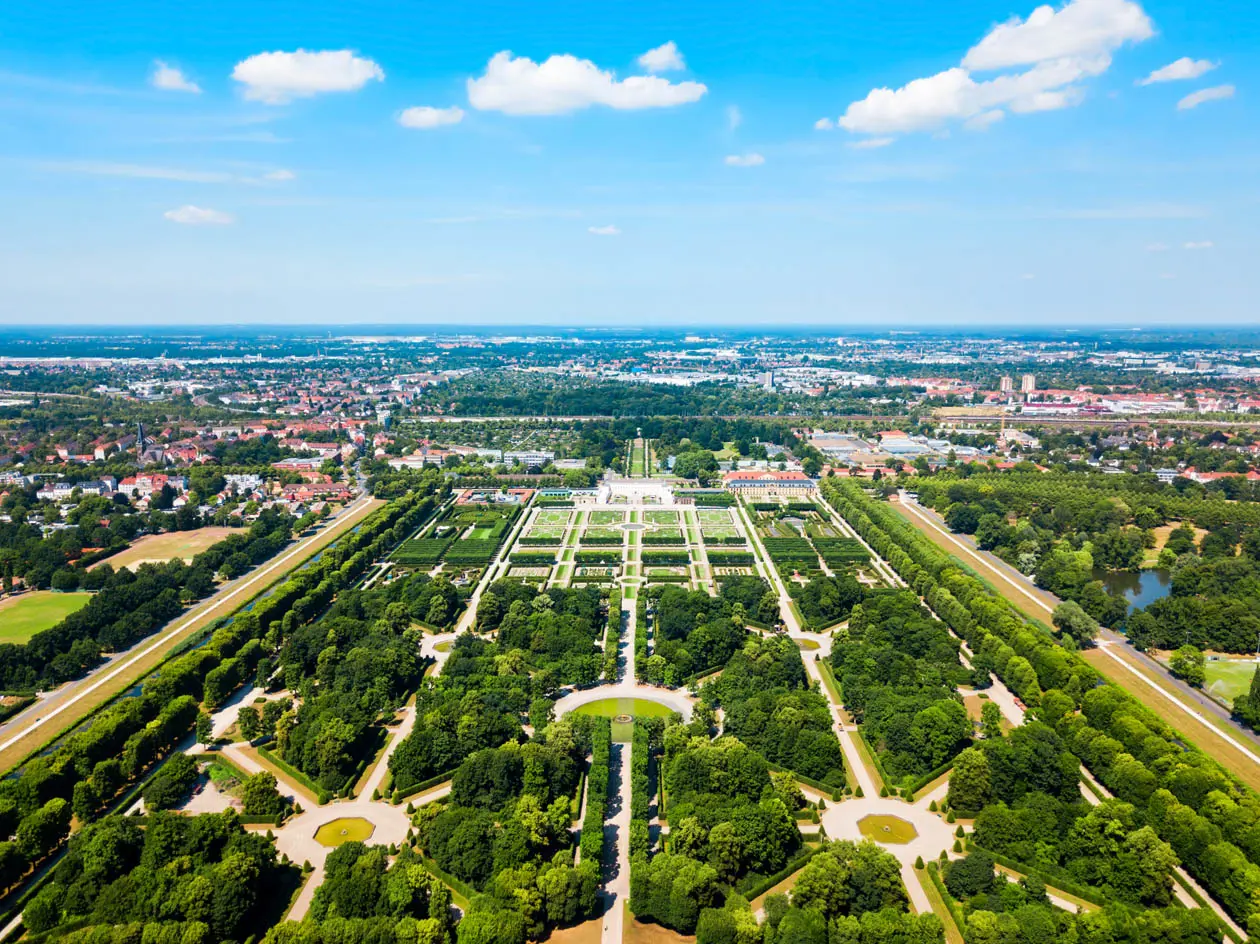
The Royal Gardens of Herrenhausen in Hanover Photo: Copyright © Sisterscom.com / Depositphotos
A relaxing stroll through the beautiful Herrenhausen Royal Gardens, one of Europe's preserved Baroque gardens, is a great way to start the day, admiring sumptuous fountains, intricate mazes, and lush flowerbeds, immersing yourself in an atmosphere of serenity and tranquility. You can also visit the nearby Sprengel Museum, one of Germany's most important modern art museums, which houses a vast collection of works by artists like Picasso, Paul Klee, and Mondrian.
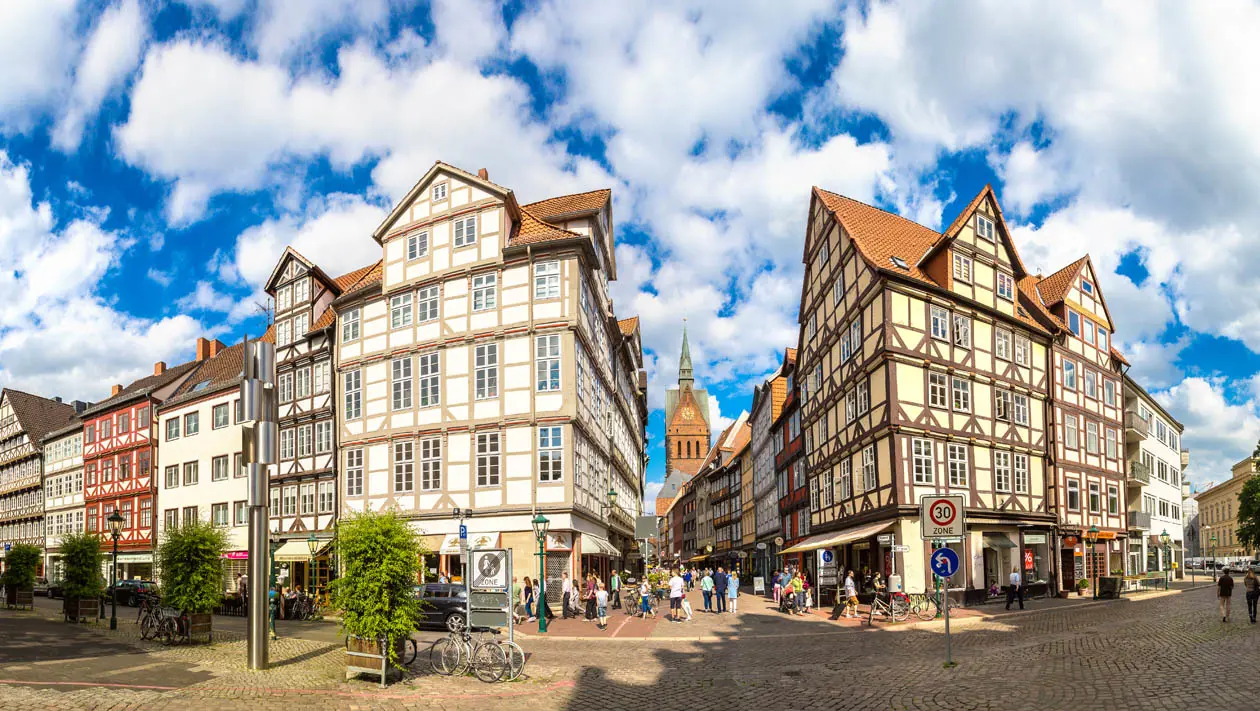
The old town of Hanover Photo: Copyright © Sisterscom.com / Depositphotos
The tour continues to the Market Square (Marktplatz) in the old town with its half-timbered houses, where you can admire the opulent facade of the medieval Old Town Hall (Altes Rathaus) dating back to 1500 AD. Next, discover the Leineschloss, the former royal residence of Hanover, and the New Town Hall (Neues Rathaus), a striking neo-Gothic building inaugurated in 1913 with a large dome that soars nearly 100 meters high, offering a panoramic view of the city from above.
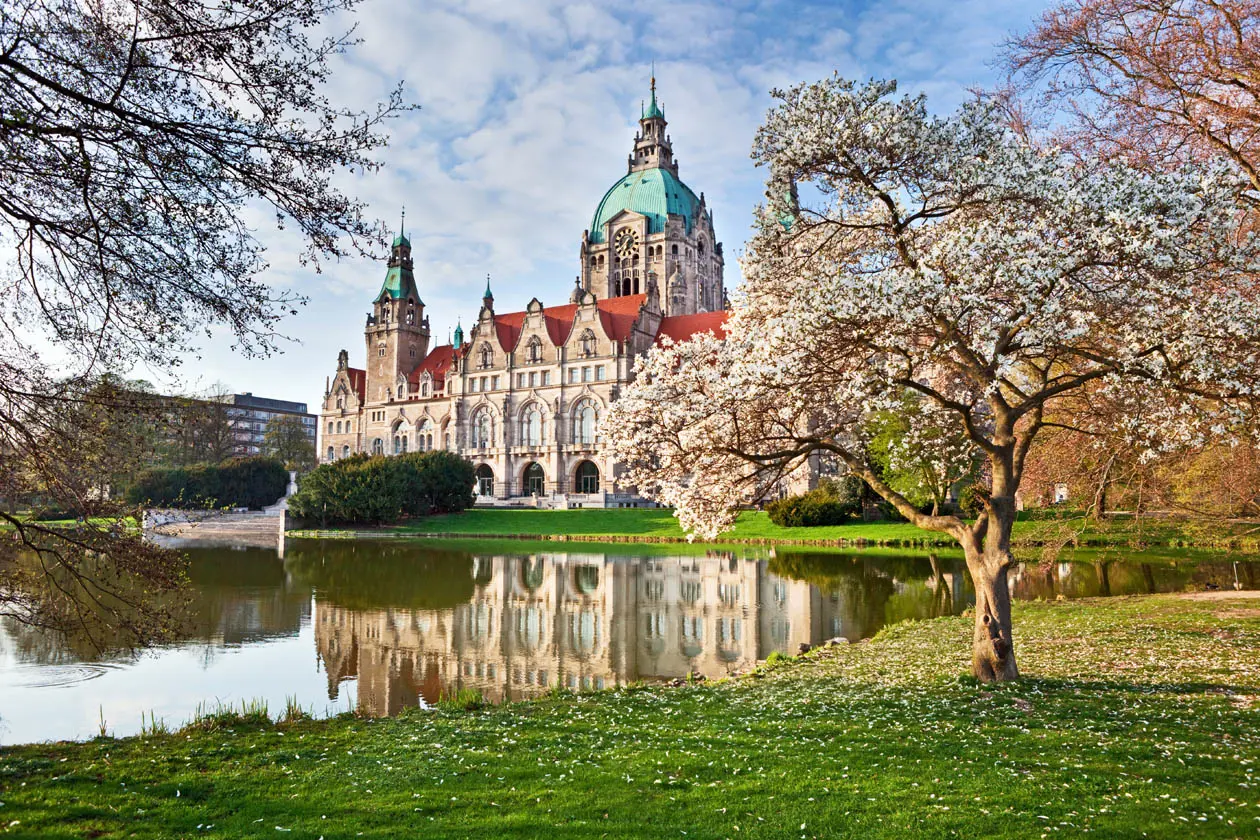
The new town hall of Hanover Photo: Copyright © Sisterscom.com / Depositphotos
Leaving the New Town Hall, you can follow the Nana Sculpture Mile by Niki de Saint Phalle to enjoy outdoor art works or relax along the Maschsee Lake, for a boat trip or to attend an event or festival on the lakeside.
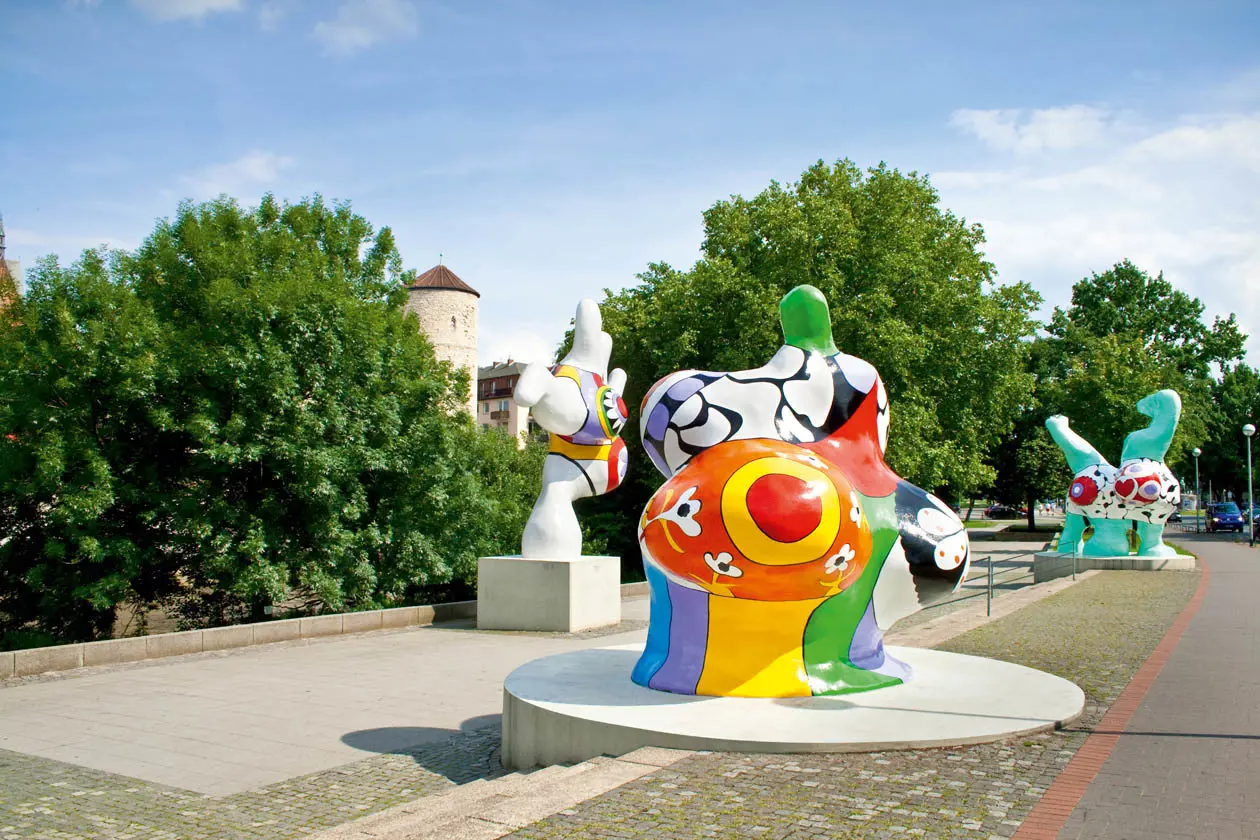
The mile of sculptures "Nana" by Niki de Saint Phalle from Hannover Photo: Copyright © Sisterscom.com / Depositphotos
For shopping in the city, from the market square, proceed with a walk along the historic Kröpcke street, the lively commercial center of Hanover, where you'll find fashion boutiques, cozy cafés, and souvenir shops, perfect for shopping or enjoying a break with a traditional German coffee. In the evening, immerse yourself in Hanover's vibrant cultural scene with a visit to Ernst-August-Platz, where you can watch opera, ballet, and concerts at the famous Hanover Opera House (Opernhaus). Continue the evening with a walk along the Leine River to enjoy breathtaking views and a relaxing atmosphere, before ending the day in one of the lively venues in the Linden area.
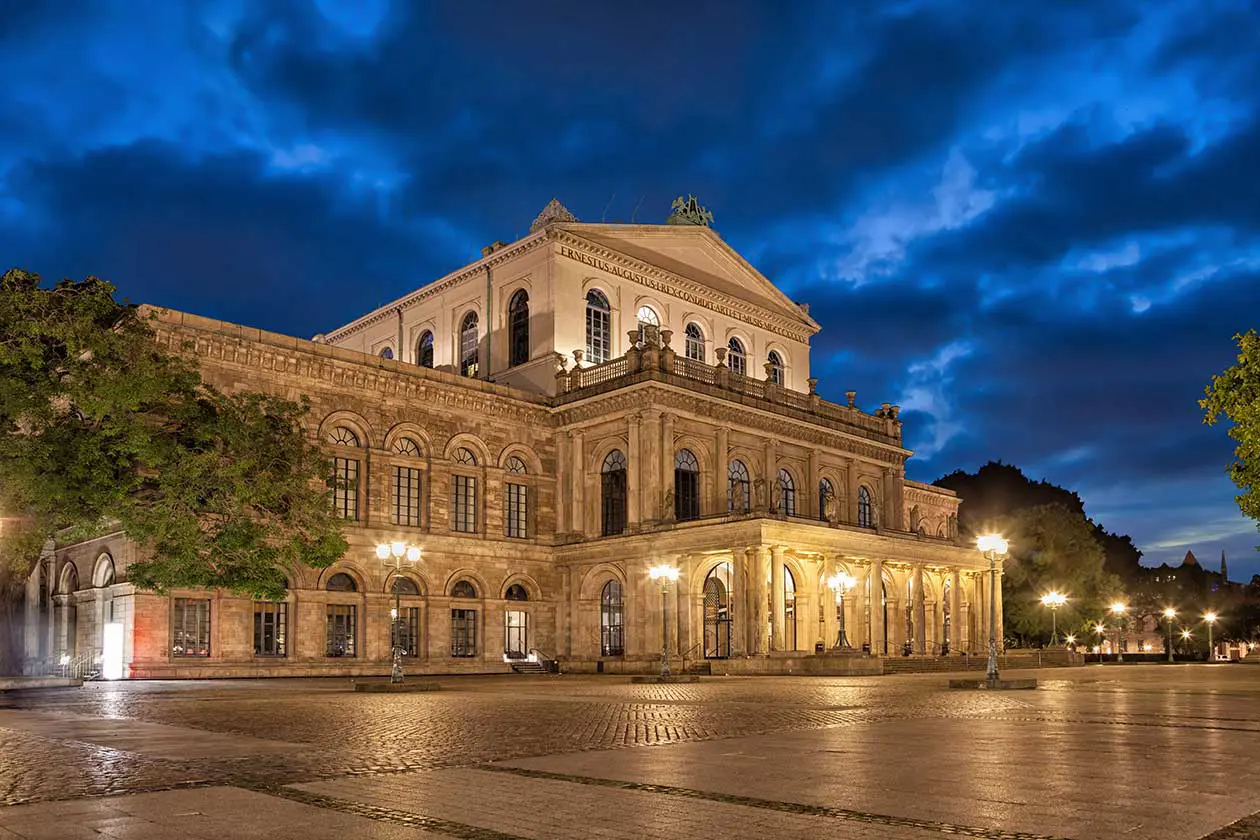
Hanover Opera Photo: Copyright © Sisterscom.com / Depositphotos
The trendy Linden district is also ideal for stopping to taste the delicious local cuisine and be tempted by the authentic flavors of German cuisine. From classic wurst and pretzels to regional delicacies like Grünkohl, a dish made from curly kale, you won't be disappointed by the variety and authenticity of the gastronomic options Hanover has to offer, paired with beer or the national drink "Lüttje Lage" made with beer and schnapps.
For those with more time and who do not want to miss all the beauties of the city, you can follow the "Red Thread" (a sort of printed guide on the ground) to walk independently on a tour, following a red line 4.2 km long and winding through 36 points of interest in the center of Hanover.
|
Hanover Photo: Copyright © Sisterscom.com / depositphotos
Hanover is a hub of artistic, historical, and cultural excellence, always lively and stimulating. Known as the capital of Lower Saxony, it is renowned as the birthplace of the genius Gottfried Wilhelm Leibniz and has been designated a "UNESCO City of Music" for its creative music scene spanning various genres including pop, rock, jazz, classical, and contemporary. Hanover is the city where vinyl was invented, the first music cassette was produced, and the first CD was printed.
|
|
Advertising
NH Hotel is a leading hotel chain in Europe that offers over 350 hotels across 28 countries. Its hotels are distinguished by excellent value for money and prime locations. You can stay in the heart of Hanover in a 4-star hotel equipped with all comforts: NH Hannover is located close to all major tourist attractions, which are easily accessible on foot, and both the subway and train station are right in front of the hotel.
|
THE NIGHTLIFE OF ROTTERDAM
From clubs to panoramic terraces, exploring the vibrant heart of the Dutch city
Text by Nicole Villa
Exploring Rotterdam after sunset offers a vibrant and unforgettable nighttime experience. This dynamic and cosmopolitan Dutch city offers much more than a picturesque skyline and bustling day-time activities. As the sun sets, Rotterdam transforms into a lively hub of nightlife with options to suit every taste. From trendy bars to lively clubs and cultural venues, Rotterdam’s nightlife provides a complete experience from happy hour until the early morning hours.
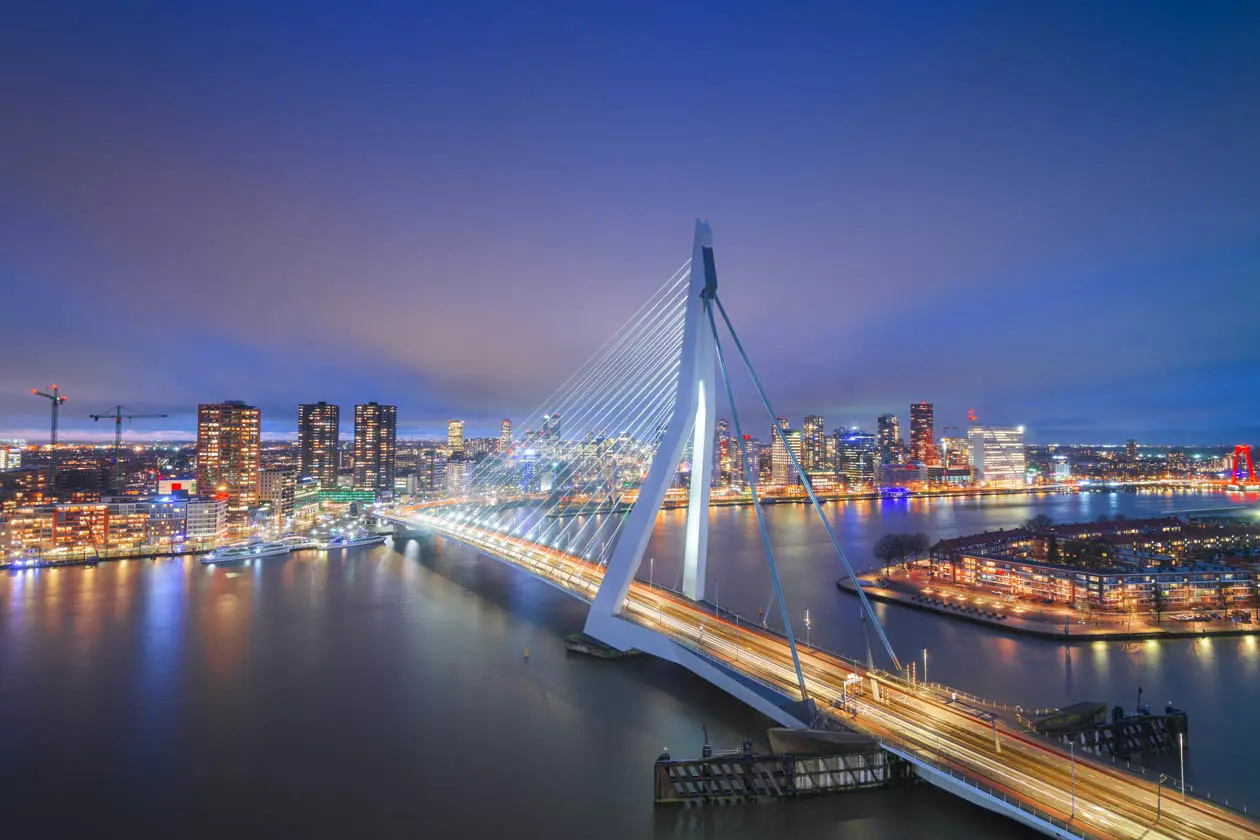
View of Rotterdam and the Erasmusbrug bridge Photo: Copyright © Sisterscom.com / Depositphotos
Happy Hour in Rotterdam
For a quick drink, you can opt for one of the many city bars, culinary hotspots, or the Markthal, a futuristic covered market. Here, you can savor famous Dutch meatballs (bitterballen) or international dishes. Among the best places to enjoy aperitifs are:
Witte de Withstraat: known as the "Cool Street", it is dotted with trendy bars, cafés, pubs, wine bars, cocktail bars, and restaurants. Here, you can enjoy artisan cocktails, local beers, and fine wines, immersing yourself in the city’s vibrant atmosphere. Don't miss Café De Witte Aap and the Ballroom, which offers innovative cocktails in a chic setting.
Nieuwe Binnenweg and surroundings: this area offers a similar vibe, with a range of renowned cafés and clubs like Café Stalles, Bar3, and Rotown / De Vegan Snackbar, which serves as a bar and restaurant during the day but transforms into a venue for concerts and events in the evening.
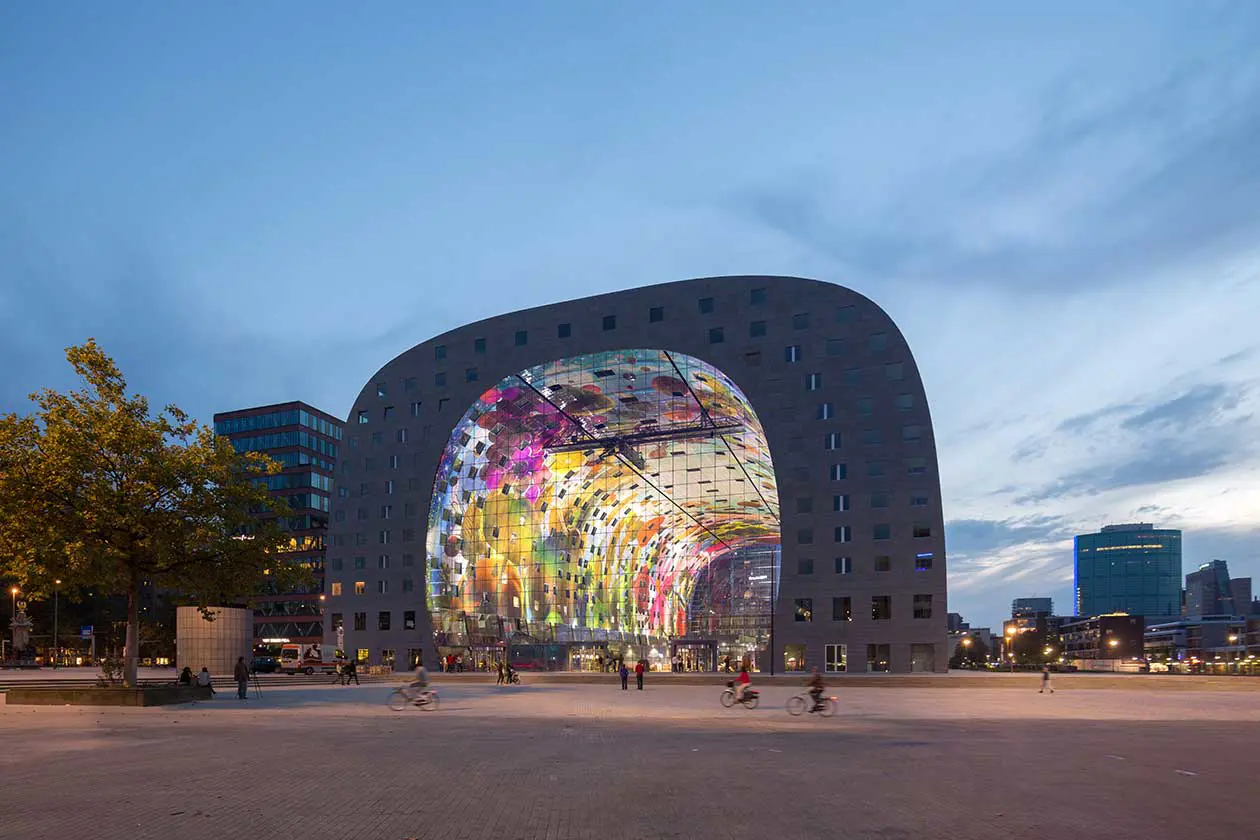
The Markthal in Rotterdam Photo: Copyright © Sisterscom.com / Depositphotos
Culinary experiences
Rotterdam boasts a rich and diverse culinary scene. Here are some must-visit restaurants:
NY Basement
located at Koninginnenhoofd 1, it offers an ambiance reminiscent of pre-war Manhattan.
De Matroos en het Meisje
located at Delistraat 52, where you choose the number of courses but leave the dish selection to the chef’s surprise.
Ristorante Tosca
located at Pijnackerstraat 120B, it features dishes inspired by Italy, France, and Spain using local Dutch ingredients.
Héroine Restaurant & Bar
located at Kipstraat 12, it features 1970s retro interiors and unconventional dishes.
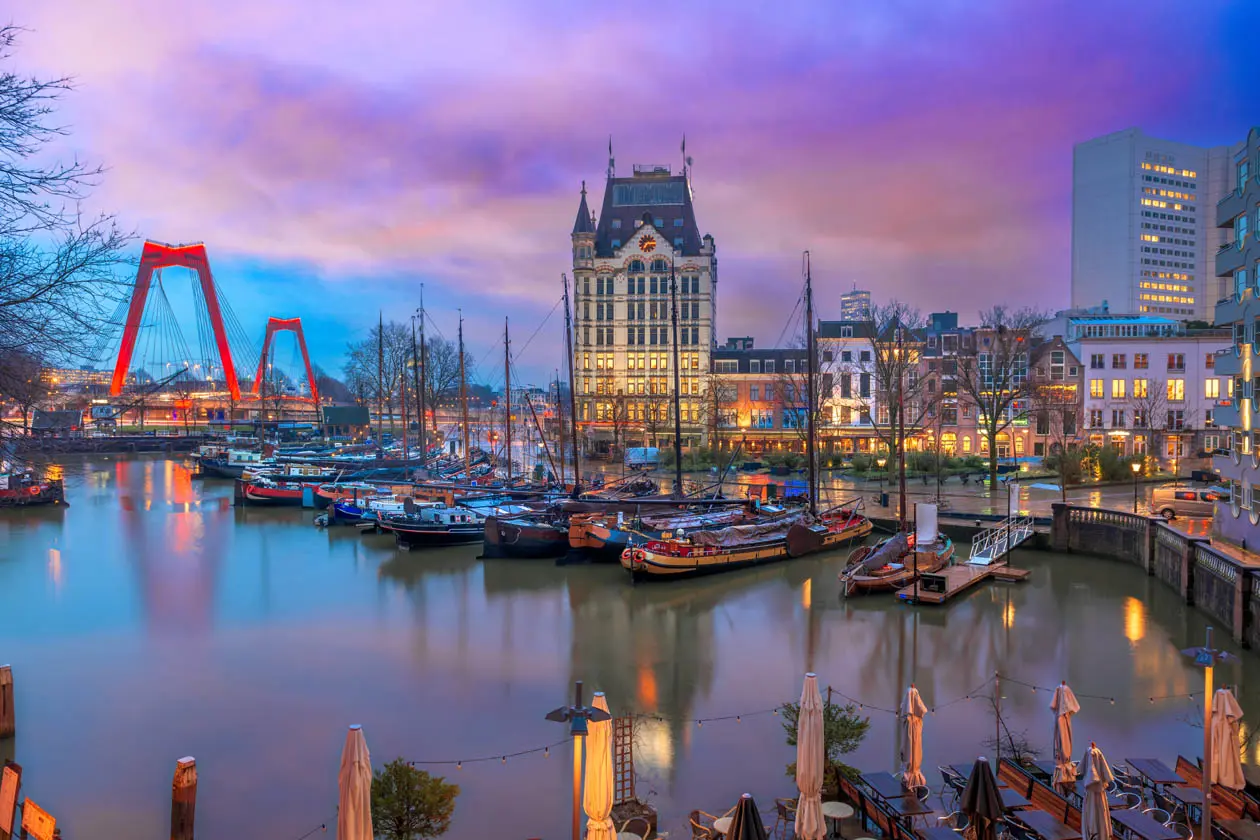
The old port of Rotterdam Photo: Copyright © Sisterscom.com / Depositphotos
Pubs and venues
After dinner, dive into the lively pub and venue scene, where you can enjoy creative cocktails, craft beers, and fine wines, possibly accompanied by live music or performances. Among the unmissable places for drinks and live music are:
Bakeliet
located at Nieuwe Binnenweg 328-C, it offers a mix of drinks, meals, and vinyl.
Jazzcafé Dizzy
located at 's-Gravendijkwal 127, it has been featuring live jazz since 1977.
The city boasts a vibrant electronic music scene, with clubs that cater to all tastes and music genres. The recommended Rotterdam clubs are:
Maassilo
housed in a former grain silo, it is known for its vast industrial space where top DJs perform.
Mavis
with a 1930s ambiance, dance until the early hours to classic vinyl records by Ella Fitzgerald, Stevie Wonder, and Curtis Mayfield.
Toffler
a house-techno club in a former subway tunnel, offering an intimate underground atmosphere with cutting-edge techno and house music.
Containerbar Noord
an outdoor party venue in a large container for fans of techno, hip-hop, or electronic beats.
Rotterdam is also gay-friendly, with numerous bars and clubs along Churchillplein, Westblaak, and Van Oldenbarneveltstraat. Notable venues include Café Strano, Cafe KeerWeer, and Ferry.
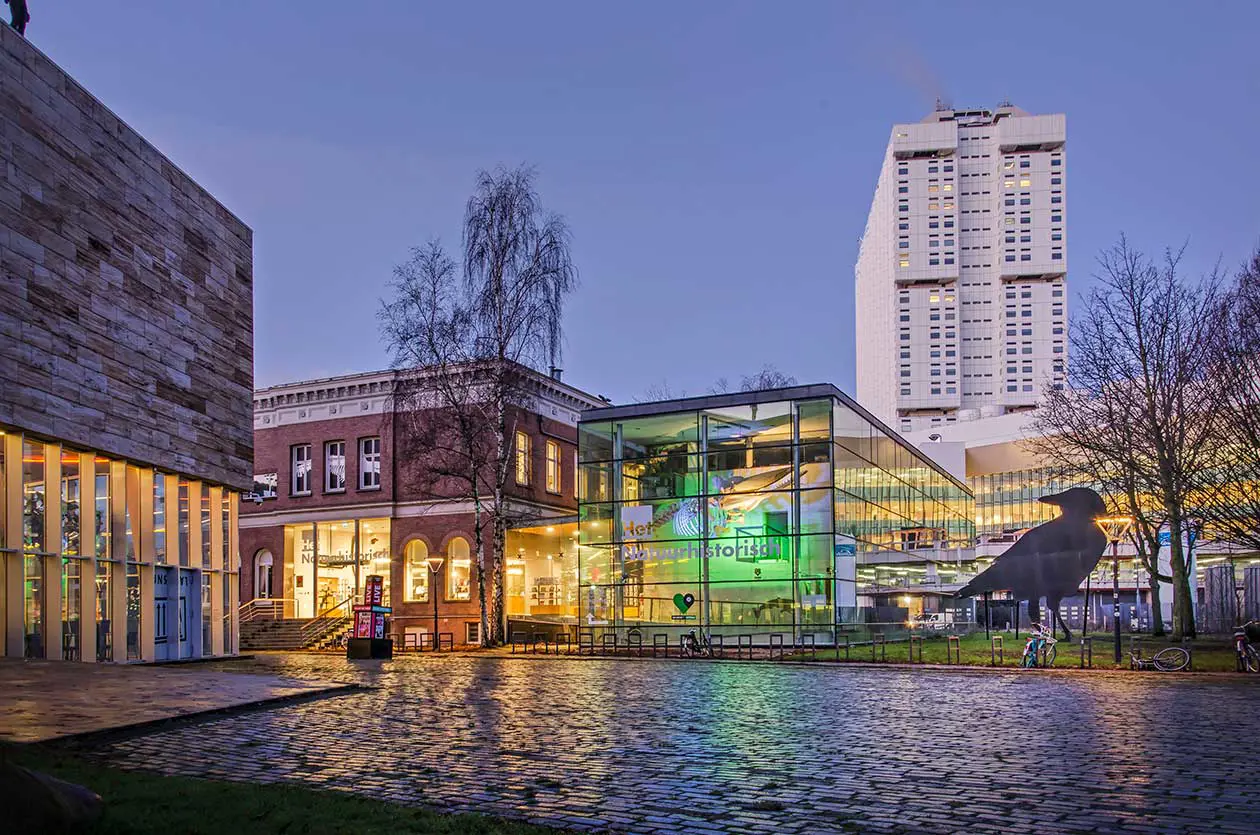
Museum Park in Rotterdam Photo: Copyright © Sisterscom.com / Depositphotos
Cultural nighttime experiences
For those seeking a more cultural nighttime experience, Rotterdam has much to offer. The city hosts numerous theaters, concert halls, and performance venues showcasing a wide array of artistic talents. Top cultural venues are:
De Doelen and Theater Rotterdam
for live music, theatrical shows, and dance performances.
Motel Mozaïque
hosts pop concerts in various locations from the Rotterdamse Schouwburg theater, to the De Doelen concert hall, to Maassilo in southern Rotterdam.
Lantaren Venster
a cultural center and cinema that features independent and international films, festivals, and jazz concerts.
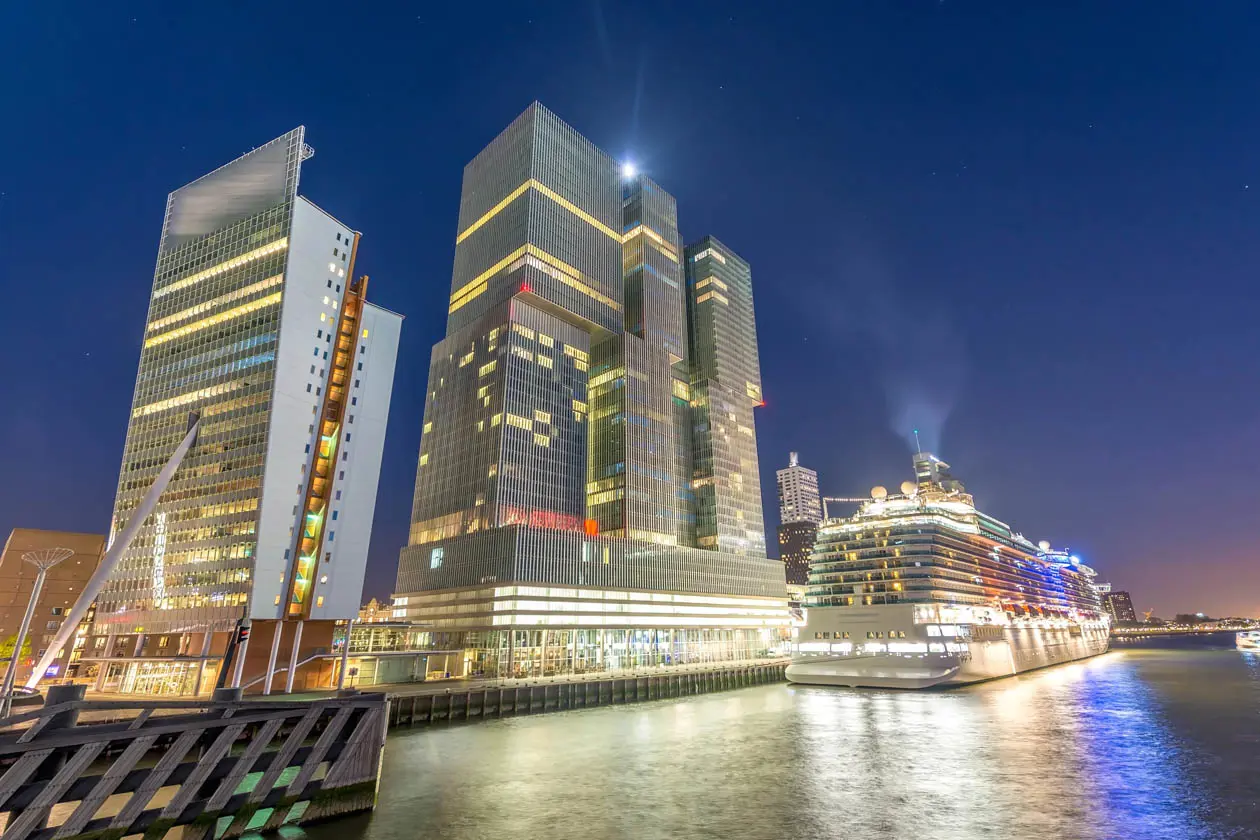
The modern building De Rotterdam and the cruise terminal in Rotterdam Photo: Copyright © Sisterscom.com / Depositphotos
Nighttime views of Rotterdam
And finally, the enchanting nighttime views of the city. No visit to Rotterdam would be complete without admiring the city skyline at night. Simply head to the iconic Erasmus Bridge, the renowned bridge over the Nieuwe Maas river also known as 'The Swan', for a panoramic view of the illuminated city against the dark sky. Alternatively, take a nighttime cruise along the river and the city harbor to admire Rotterdam's modern architecture and sparkling lights from a different perspective.
|
Rotterdam Photo: Copyright © Sisterscom.com / depositphotos
Rotterdam is the second largest cosmopolitan city in the Netherlands. This metropolis of unique charm has a dynamic nature and innovative mindset. Also known as ‘the Manhattan on the Meuse’, Rotterdam is famous for its skyline of skyscrapers.
|
|
Advertising
What to do in Rotterdam
Tiqets is an online booking platform that offers a rich variety of experiences, from museums to tourist attractions. Find out what you can do in Rotterdam such as sailing between bridges and architecture with interesting cruises, climbing the Euromast tower or venturing with Rotterdam city tours to discover its beauties.
|
OVIEDO AND THE PARADISE OF ASTURIAS
Ideal destination for nature and culture enthusiasts
Text by Lisa Maria River
Situated in the northwest of Spain, the Principality of Asturias offers an authentic taste of Spain's nature with the majestic mountains of the Cantabrian Range and the rugged coasts of the Cantabrian Sea, while the regional culture is rich with history and typical gastronomic traditions.
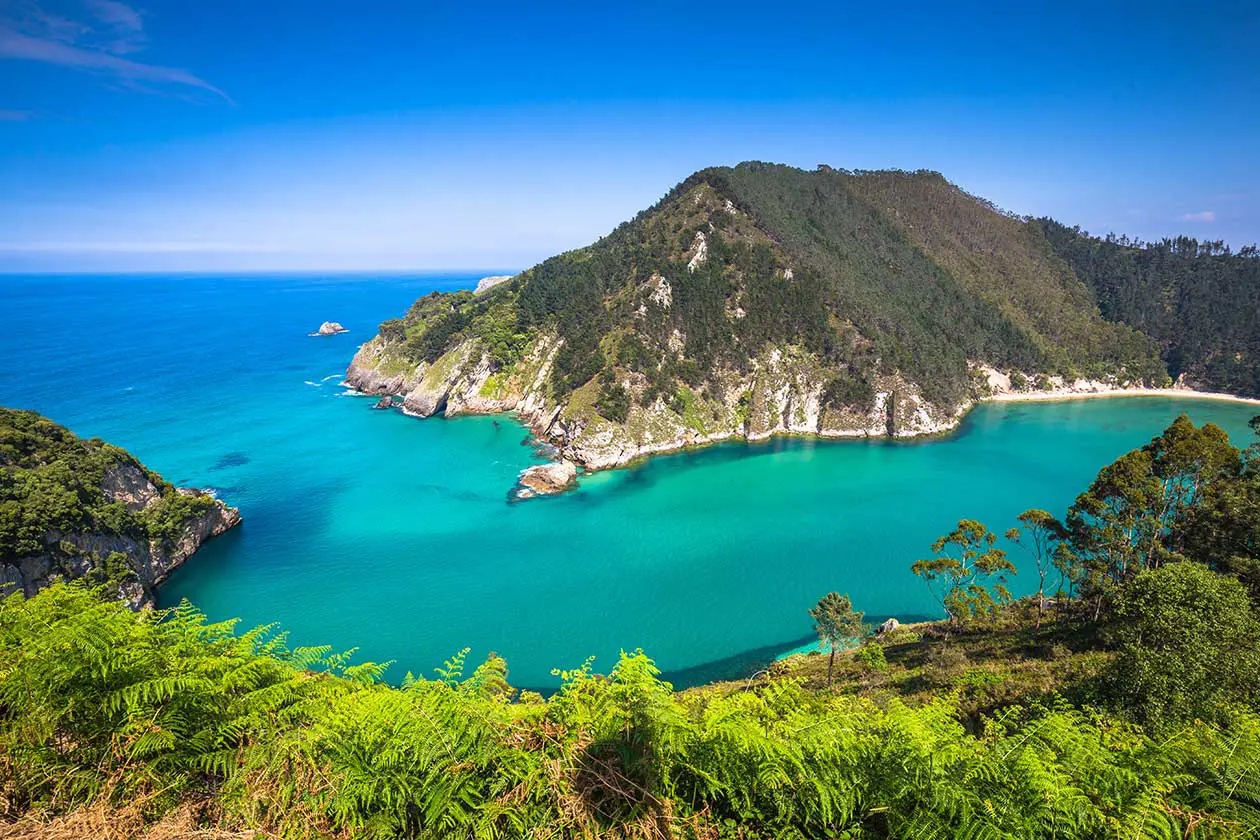
Lower estuary from Mirador Tina Minor. Municipality of Val de San Vicente, Cantabria. Photo: Copyright © Sisterscom.com / Shutterstock
Asturias provides an authentic taste of Spanish nature, offering a retreat from the hustle and bustle of tourist cities at a pace that invites reflection and full enjoyment of nature and culture. Here, the green landscapes remain indelibly in the memory like the Picos de Europa National Park and the Lakes of Covadonga, coveted spots for those seeking a holiday immersed in nature with options for simple outdoor activities or more vigorous sports.
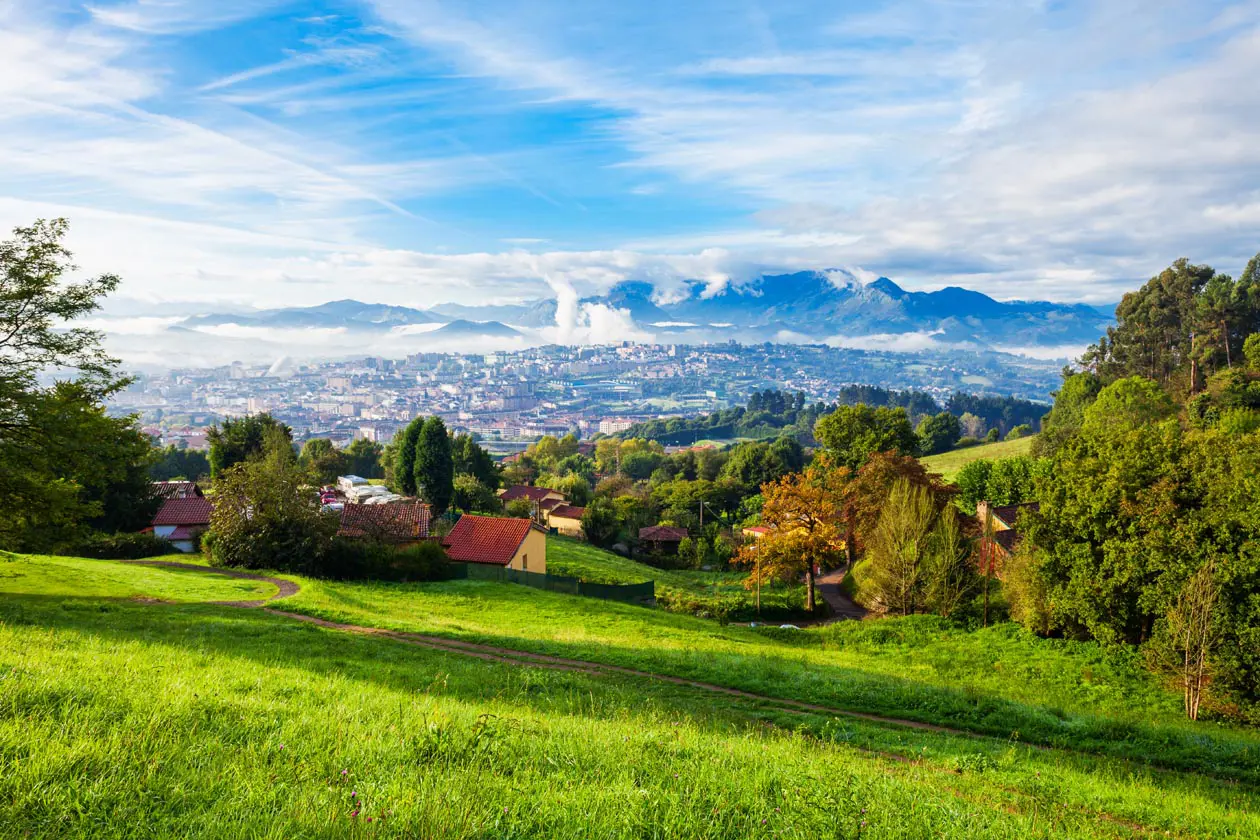
Oviedo capital of Asturias Photo: Copyright © Sisterscom.com / Shutterstock
To visit the highlights of the region, through nature, historical heritage, and culinary delights, the city of Oviedo with its city airport serves as an excellent starting point to then explore Asturias and its beauties by renting a car, providing the right flexibility to visit various places in relatively short times and with greater convenience. Allocating 1 or 2 days to visit the main tourist attractions of Oviedo requires at least another 4 days to discover the most important attractions of Asturias, from the sea to the mountains. If desired, one can always use Oviedo as a base, go on day trips, and return to the city in the evening.
Oviedo, heart of Asturias
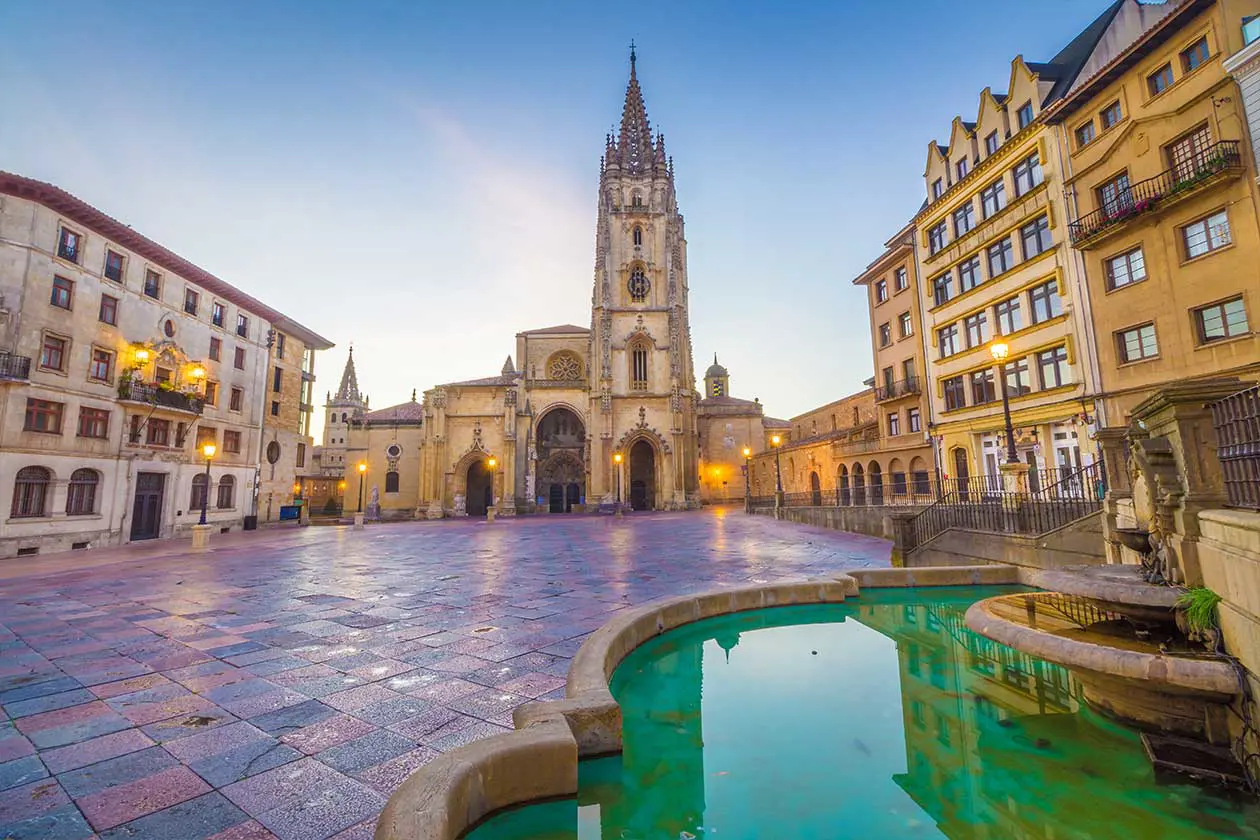
San Salvador Cathedral in Oviedo Photo: Copyright © Sisterscom.com / Depositphotos
Starting from the capital and heart of Asturias, Oviedo is a city that exudes urban elegance and ancient charm. Its well-preserved medieval historic center can be explored by visiting the Cathedral of San Salvador, famous for its Gothic architecture and spiritual significance on the Camino de Santiago, as well as the Pre-Romanesque churches of San Miguel de Lillo and Santa María del Naranco or the Church of San Julián de los Padros, architectural jewels declared UNESCO World Heritage Sites.
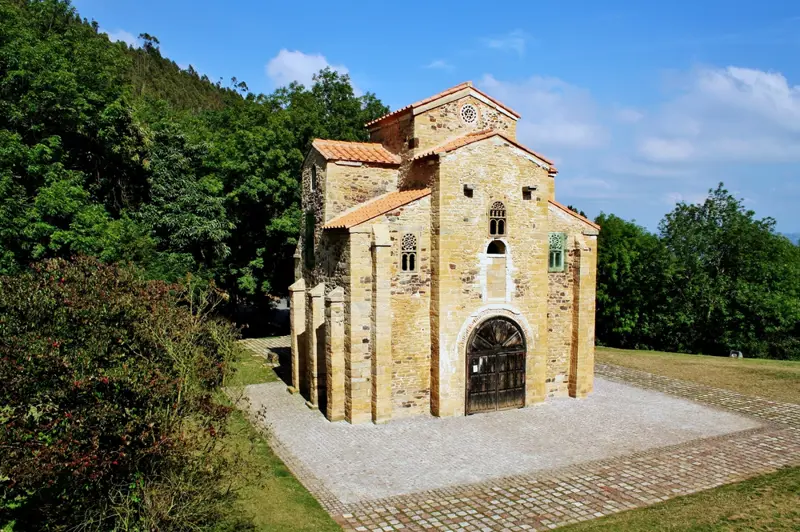
San Miguel de Lillo Photo: Copyright © Sisterscom.com / Shutterstock
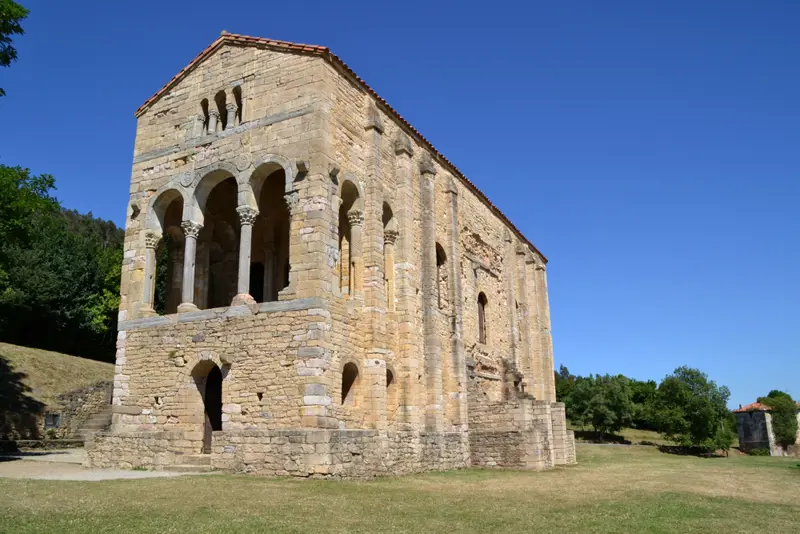
Santa María del Naranco Photo: Copyright © Sisterscom.com / Shutterstock
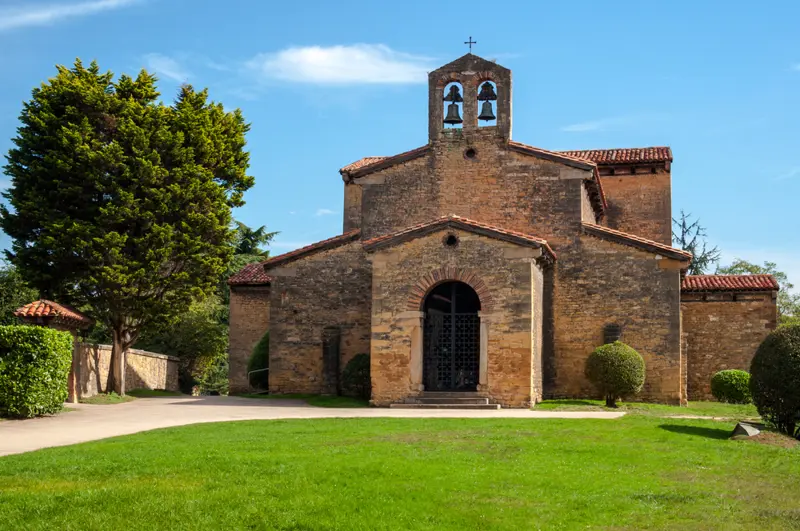
Church of San Julián de los Padros Photo: Copyright © Sisterscom.com / Shutterstock
The Mountains and Picos de Europa
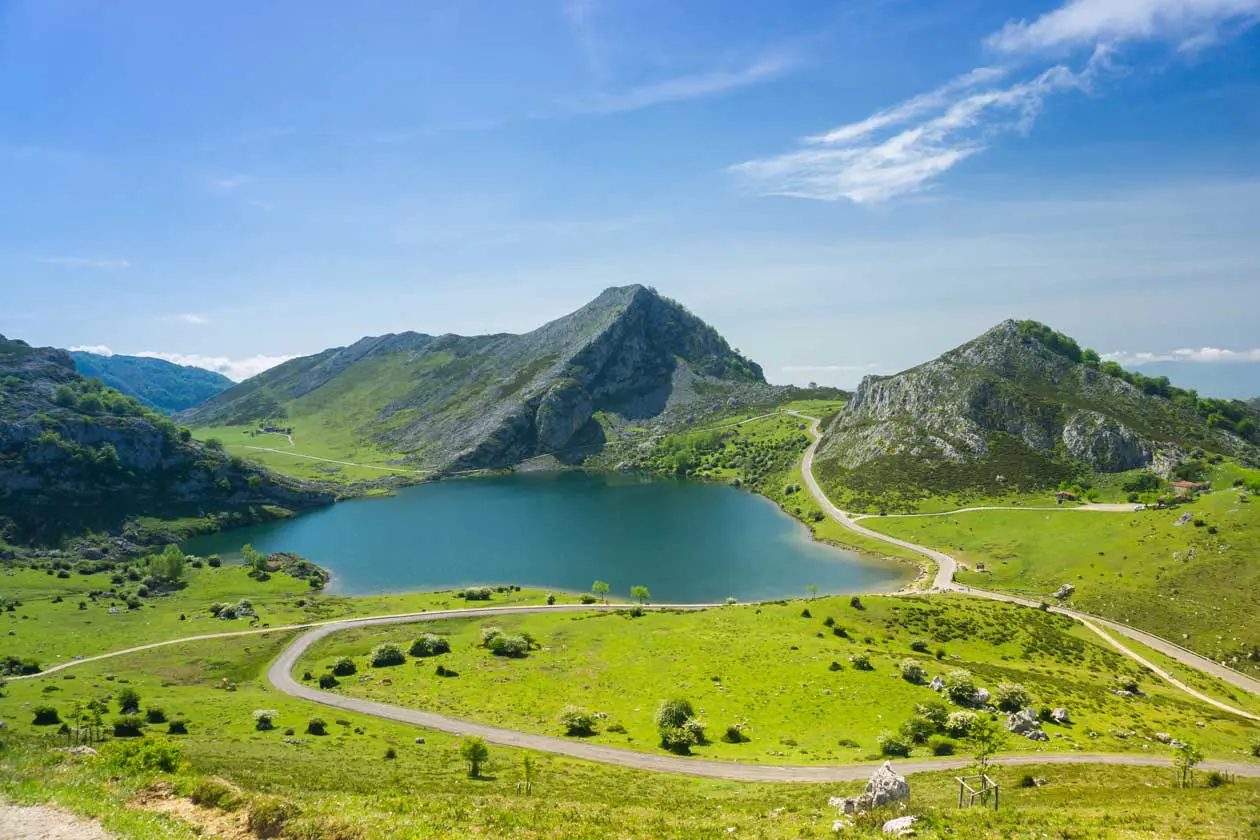
Covadonga Lakes in the Picos de Europa National Park Photo: Copyright © Sisterscom.com / Depositphotos
An adventure in Asturias wouldn't be complete without visiting the Picos de Europa National Park, a spectacular mountain range with 40 peaks over 2500 meters high with forests of beech and oak trees offering exceptional opportunities to simply enjoy nature or to engage in hiking, trekking, climbing, and canyoning.
Starting from Cangas de Onís (about 35 minutes by car from Oviedo), a charming town that serves as the gateway to the national park. From here, one can explore the famous Lakes of Covadonga (Enol and La Ercina, 90 km from Oviedo) of glacial origin with the Belvedere of the Princesa at Lake Enol and the Sanctuary of Covadonga with the Holy Cave dedicated to the Virgin of Covadonga, a pilgrimage site and place of great natural beauty.

Covadonga Sanctuary Photo: Copyright © Sisterscom.com / Depositphotos
An hour's drive from the Basilica, one traverses the Cares Trail, the most famous mountain path in Asturias (12 km trail in about four hours), while less than 20 kilometers from Cangas de Onís, one can also visit the Belvedere of Fito, one of the most beautiful viewpoints in the park. If preferred, after the excursions, one can return to Oviedo for the evening and relax in one of its cafes or cider houses or opt for an overnight stay in one of the picturesque local villages.
Villages and Traditions
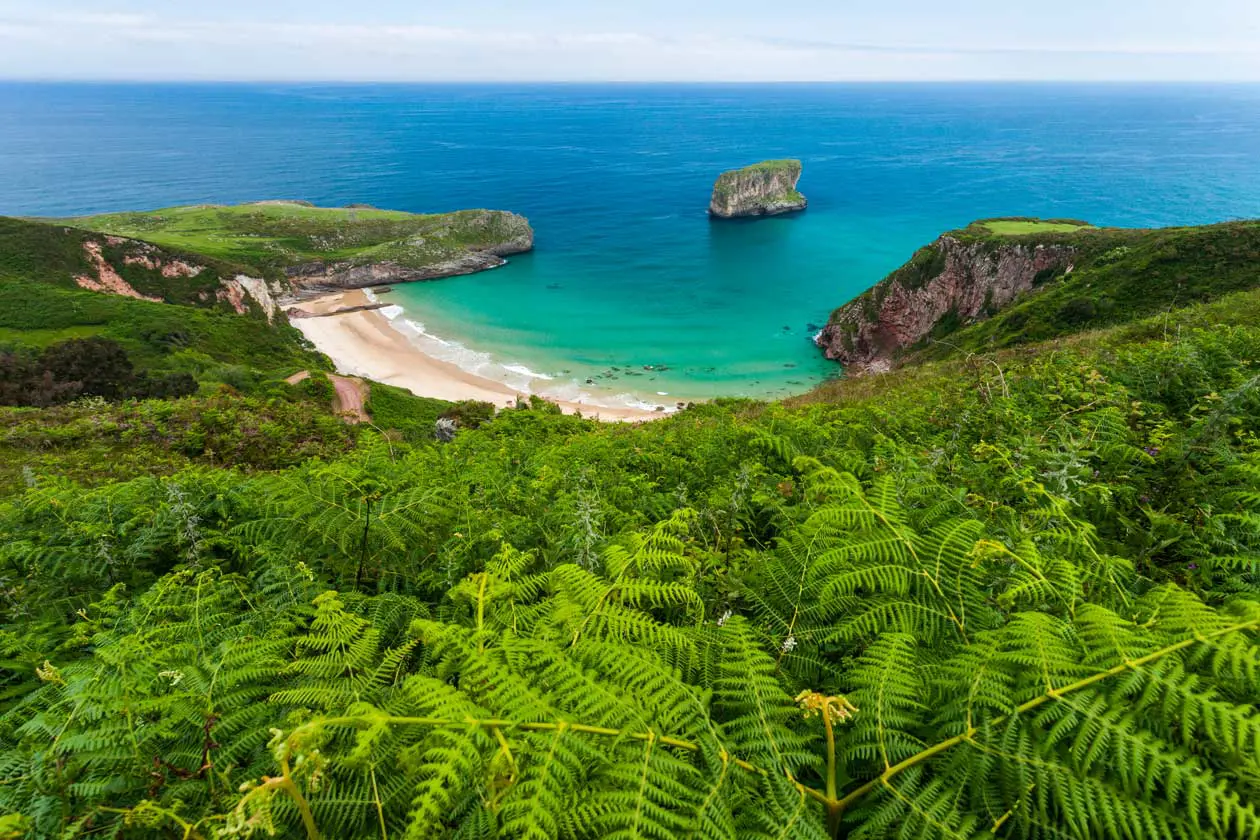
Ballota beach with the Castro islet of the village of Llanes Photo: Copyright © Sisterscom.com / Depositphotos
To better understand the local traditions, some of the most charming villages in Asturias remain to be explored. For example, Tazones and Llanes, which can be reached by car (Tazones about an hour from Oviedo, Llanes just over an hour). Tazones, a charming fishing village in Asturias, is famous for its history linked to the arrival of Charles V in Spain and for its colorful houses and cobbled streets. While Llanes is another picturesque coastal town with a strong medieval heritage, ideal for strolling among old palaces and along the harbor. One can explore their natural and historical beauties or taste local specialties in small restaurants such as mariscada (a mixed seafood dish), navajas (razor clams), and local lobster.
|
Oviedo Photo: Copyright © Sisterscom.com / depositphotos
The capital of Asturias is Oviedo, which boasts unique Pre-Romanesque architecture, a legacy of the Asturian monarchy from the 9th century, a time when Asturias was an autonomous kingdom.
|
|
Advertising
Booking.com hotel offers
Book a trip by 30 September to save at least 15% on stays
Save on new stay bookings at participating properties, marked with the "Gataway Deals" label in the search results and room selection pages.
|
TBILISI'S CULINARY AND WINE CULTURE
A journey through the flavors and traditions of the Georgian capital
Text by Nicole Villa
A trip to Tbilisi, the capital of Georgia, offers the opportunity not only to discover the natural, artistic, cultural, and historical beauties of the city but also to experience its oldest culinary and hospitality traditions. It is precisely by savoring an authentic meal served with native Georgian wine that one relives its ancient enogastronomic heritage rich in colors, taste, and special aromas. Not surprisingly, Georgia is also renowned for its delicious cuisine and especially for its wines.
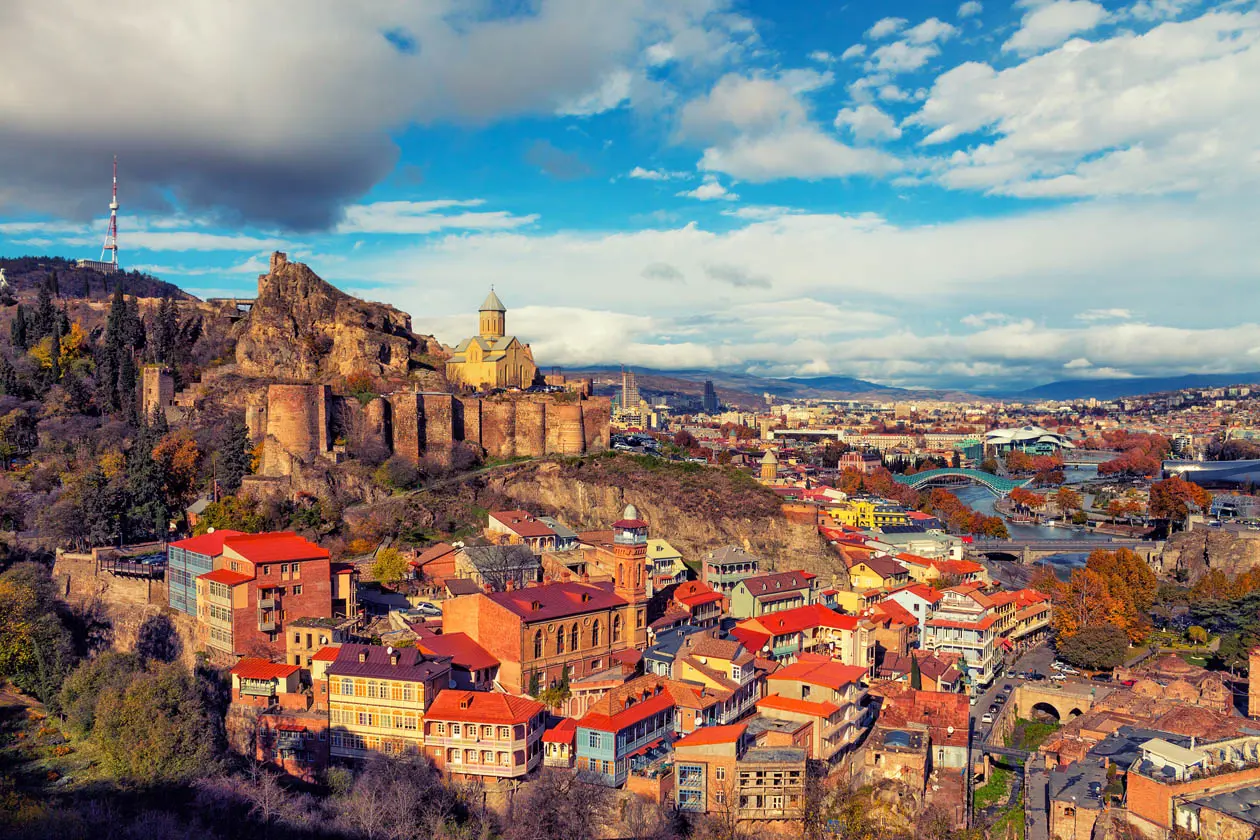
Tbilisi Photo Copyright © Sisterscom.com / Depositphotos
Thanks to the warm-humid climate of the Black Sea and the fertile soil nourished by the pure waters of the Caucasus Mountains, wine production in Georgia is ancient, dating back more than 8,000 years with the earliest traces of viticulture found in the Neolithic settlement of Shulaveri Gora from the 2nd and 3rd millennia BC.
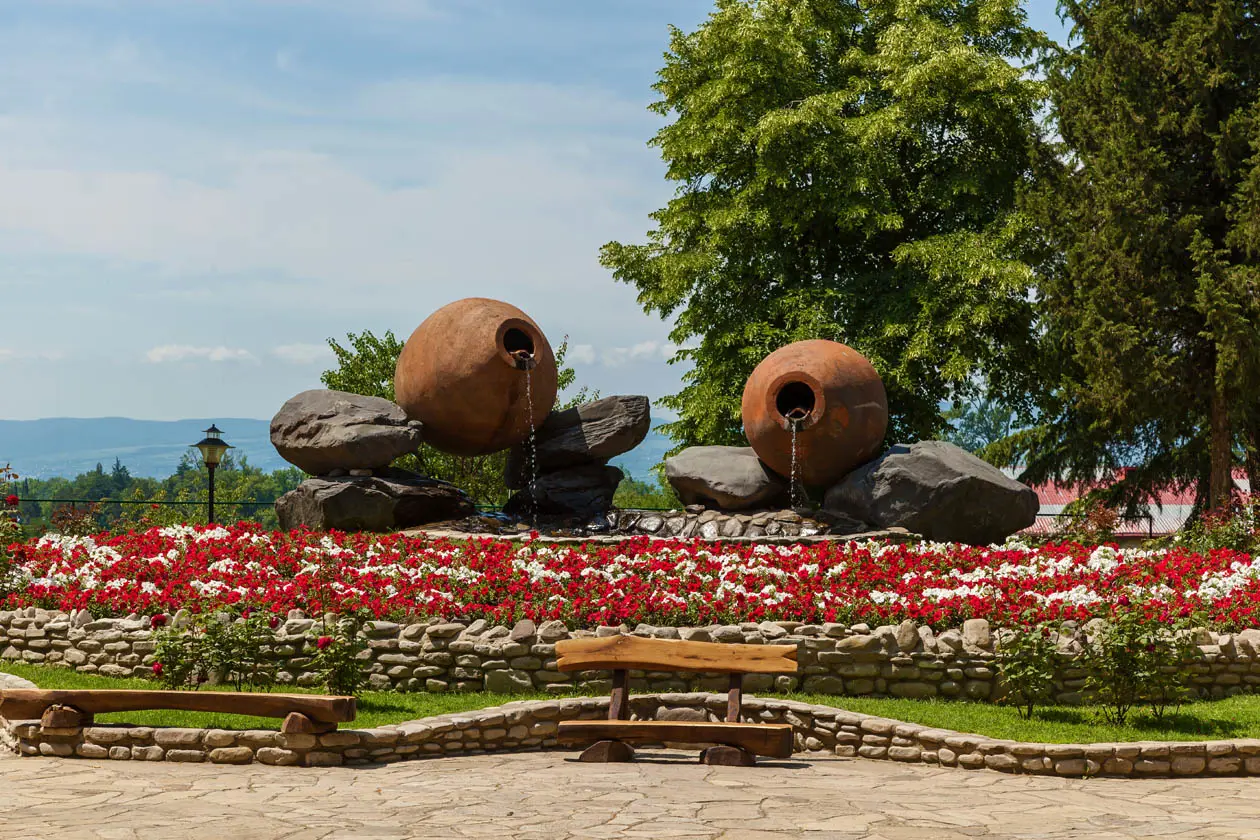
Fountains with qvevri amphorae Photo Copyright © Sisterscom.com / Depositphotos
At the heart of Georgian winemaking is the qvevri, an egg-shaped terracotta vessel used for producing, aging, and storing wine. The qvevri containing the wine is sealed and buried in the ground, fermenting for five or six months before it is ready to drink. Since 2013, the ancient traditional Georgian qvevri winemaking method has been listed on UNESCO's Representative List of the Intangible Cultural Heritage of Humanity and continues to produce quality wine from over 500 varieties of cultivated grapes.
Surrounding the city of Tbilisi are nine regions dedicated to vine cultivation for the production of local wines like Kakheti (the main wine-producing region of Georgia that houses 65-70% of all Georgian vineyards, where one can taste the semi-sweet wines Kindzmarauli and Akhasheni), Kartli (a region that starts from the outskirts of Tbilisi and extends to Imereti, known for its high-quality sparkling wines), Mtskheta-Mtianeti (a region with several wineries known for mountains, archaeological sites, and the Gudauri ski resort), ideal for venturing into a gastronomic itinerary in the spirit of ancient traditions, wine tastings, and typical dishes.
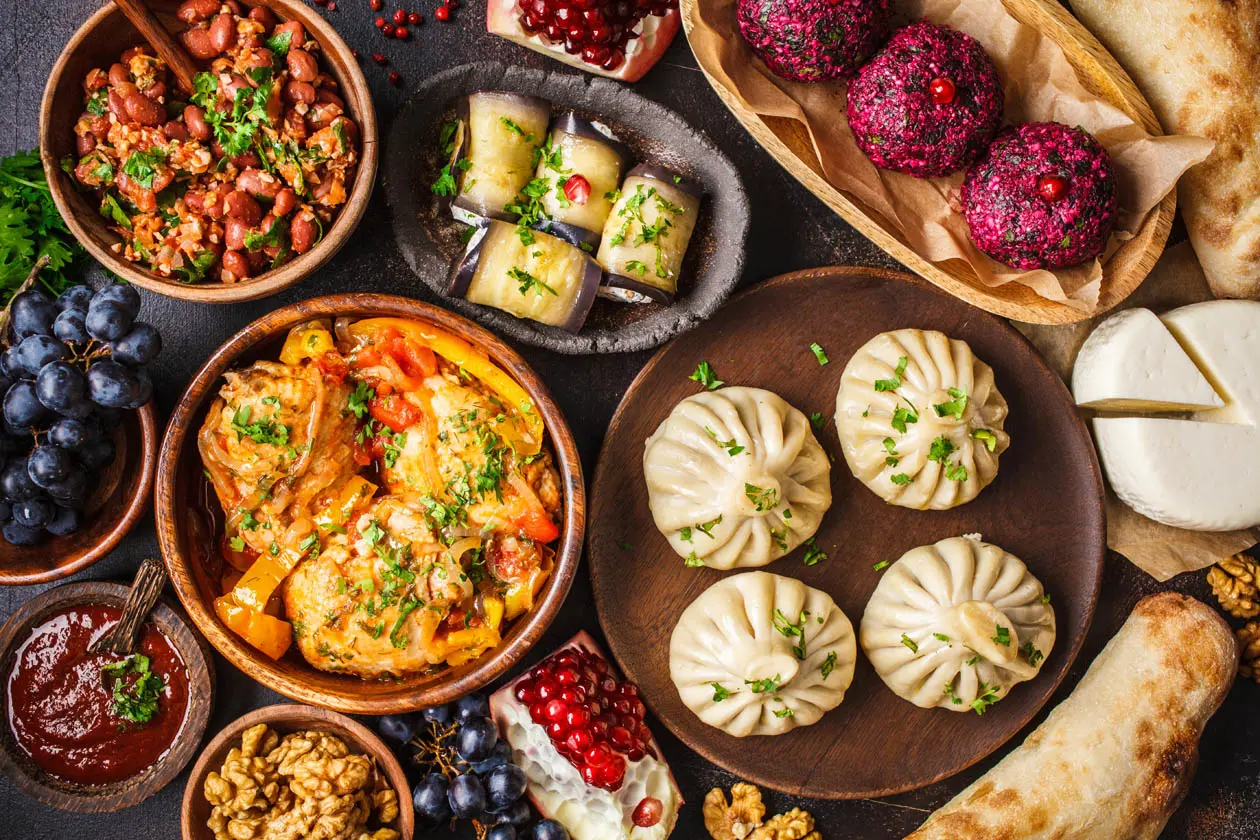
Dishes of traditional Georgian cuisine Photo Copyright © Sisterscom.com / Depositphotos
Traditional Georgian cuisine is hearty and offers a variety of dishes always paired with various wild herbs, chili, mint, basil, garlic, coriander, and spices in large quantities. A staple food is meat, such as ribs, but also vegetarian dishes with salads, vegetables, and fruits grown locally. Traditional Georgian dishes are prepared with pork, lamb, chicken, or fish to which hazelnuts, walnuts, cheeses, pickles, eggplants, plums, corn, pomegranates, beans, and shallots are added.

Khinkali Photo Copyright © Sisterscom.com / Depositphotos
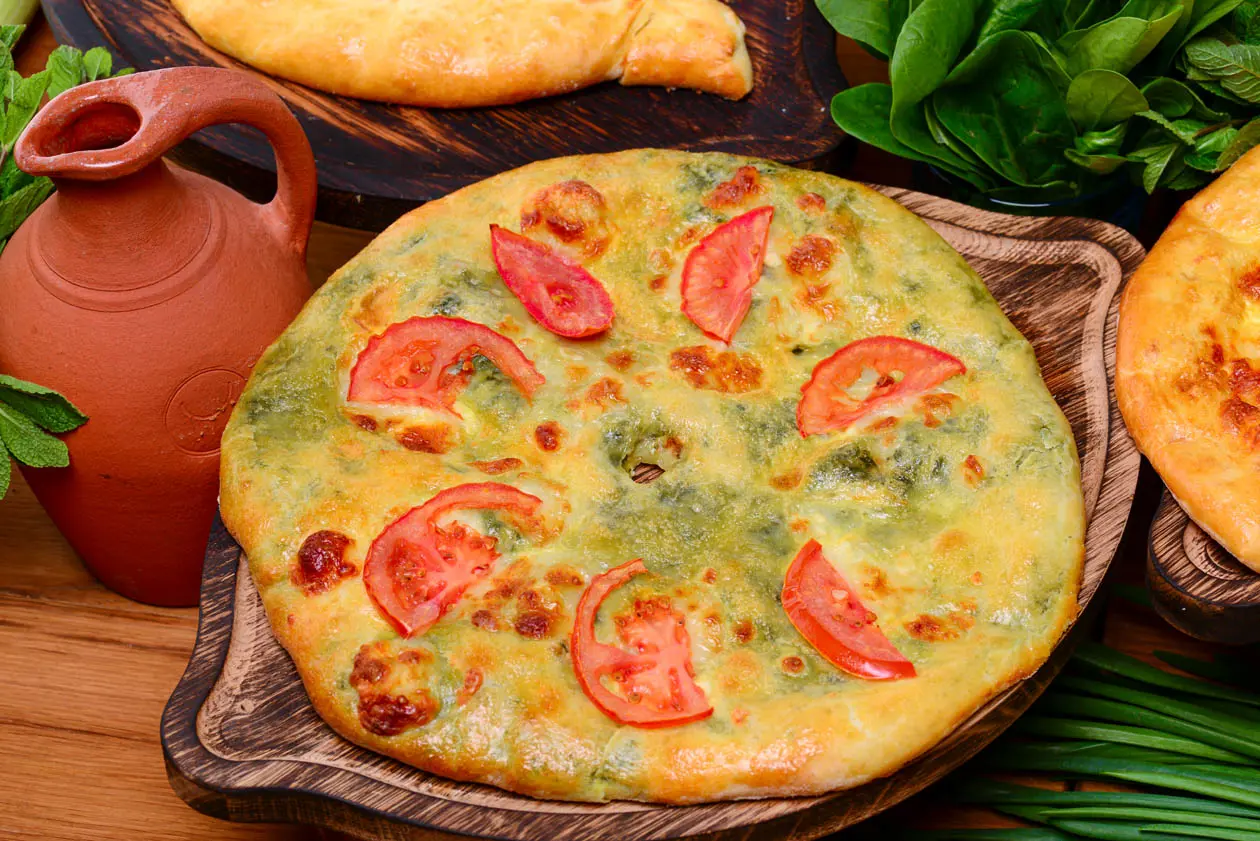
Khachapuri Photo Copyright © Sisterscom.com / Depositphotos
Worth trying is the national Georgian dish eaten with hands, Khinkali, boiled dumplings stuffed with meat, originating from the mountainous regions of the Caucasus of Khevsureti, Mtiuleti, Tusheti, and Pshavi. Another national dish is Khachapuri, a sort of pizza made of Georgian bread and cheese.
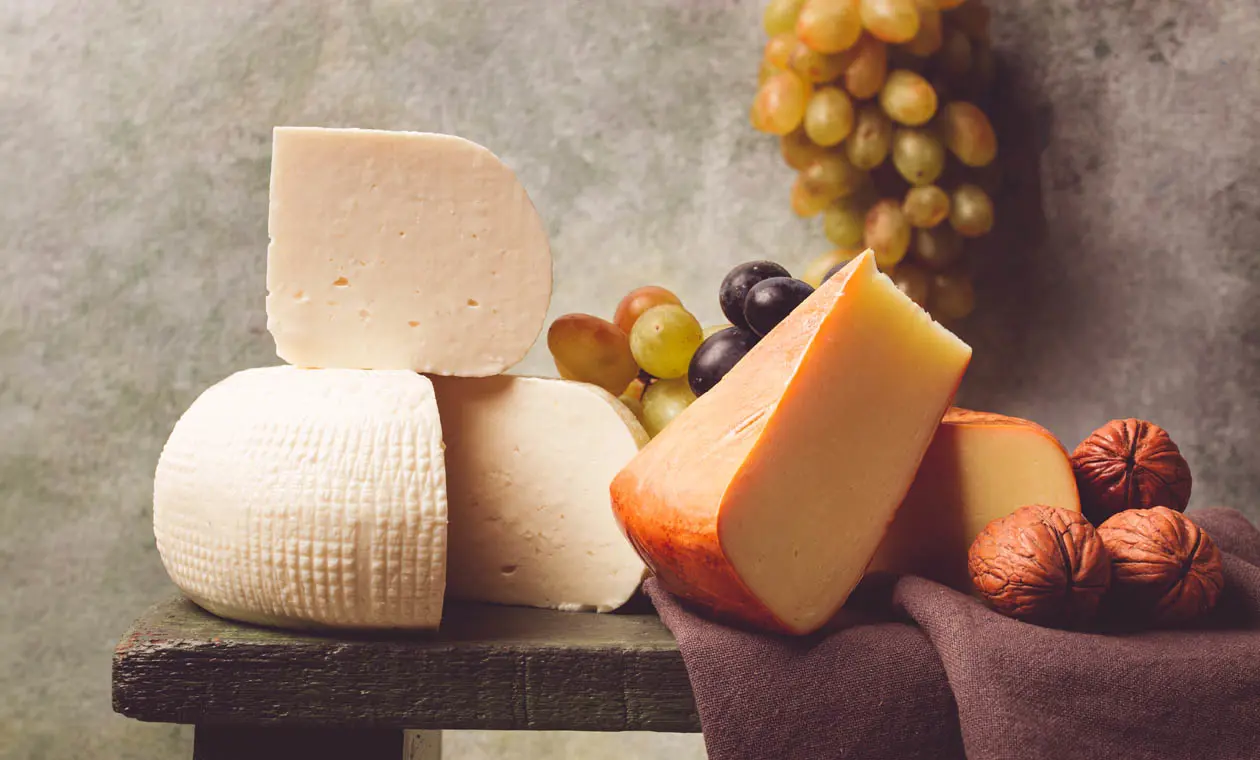
Imeruli Photo Copyright © Sisterscom.com / Depositphotos
Cheese is typical in every region of Georgia and is prepared in different ways. Imeruli is a traditional white, cow's milk cheese that originated in Imereti and is a favorite for preparing Khachapuri. Two well-known Georgian cheeses are Tenili (a variety of string cheese from the Samtskhe-Javakheti region) and Dambal-khacho (mold cheese from the Pshavi region).
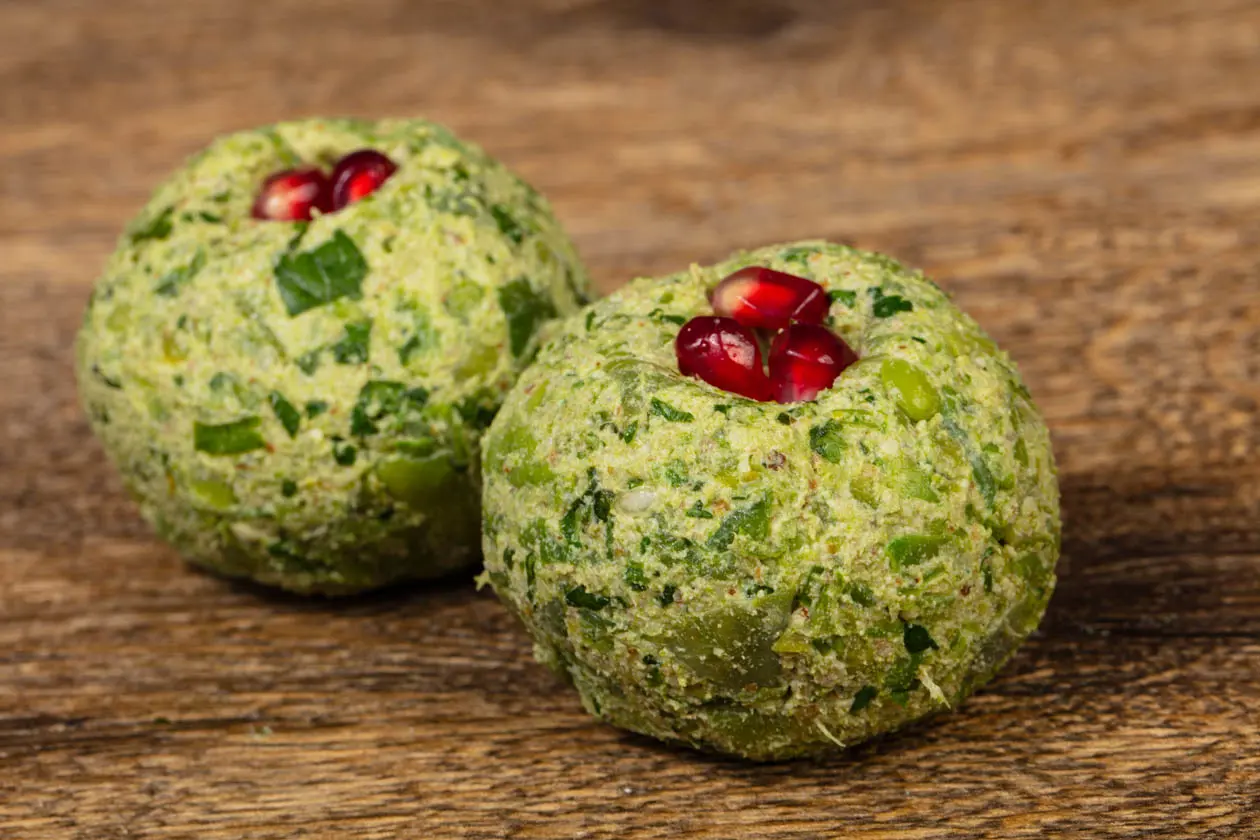
Pkhali Photo Copyright © Sisterscom.com / Depositphotos
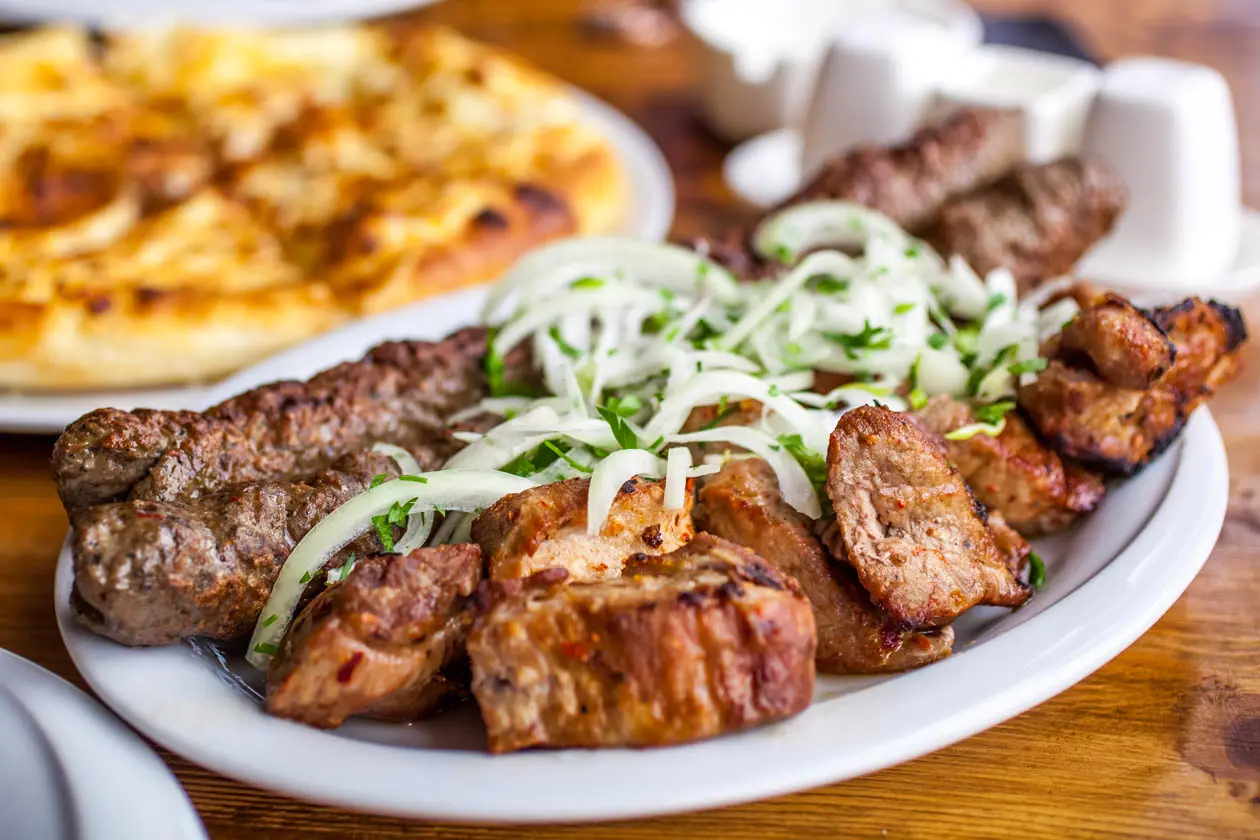
Mtsvadi Photo Copyright © Sisterscom.com / Depositphotos
Vegetarians can also try Pkhali made with chopped vegetables seasoned with walnuts, vinegar, onions, herbs, and spices. Among the unique main dishes is Mtsvadi, Georgian barbecue with grilled meat prepared on a vine-wood grill, with fresh pomegranate juice squeezed on top. Among the various meat soups, one can savor Chikhirtma (white meat broth with beaten eggs in vinegar flavored with garlic, parsley, and fennel).
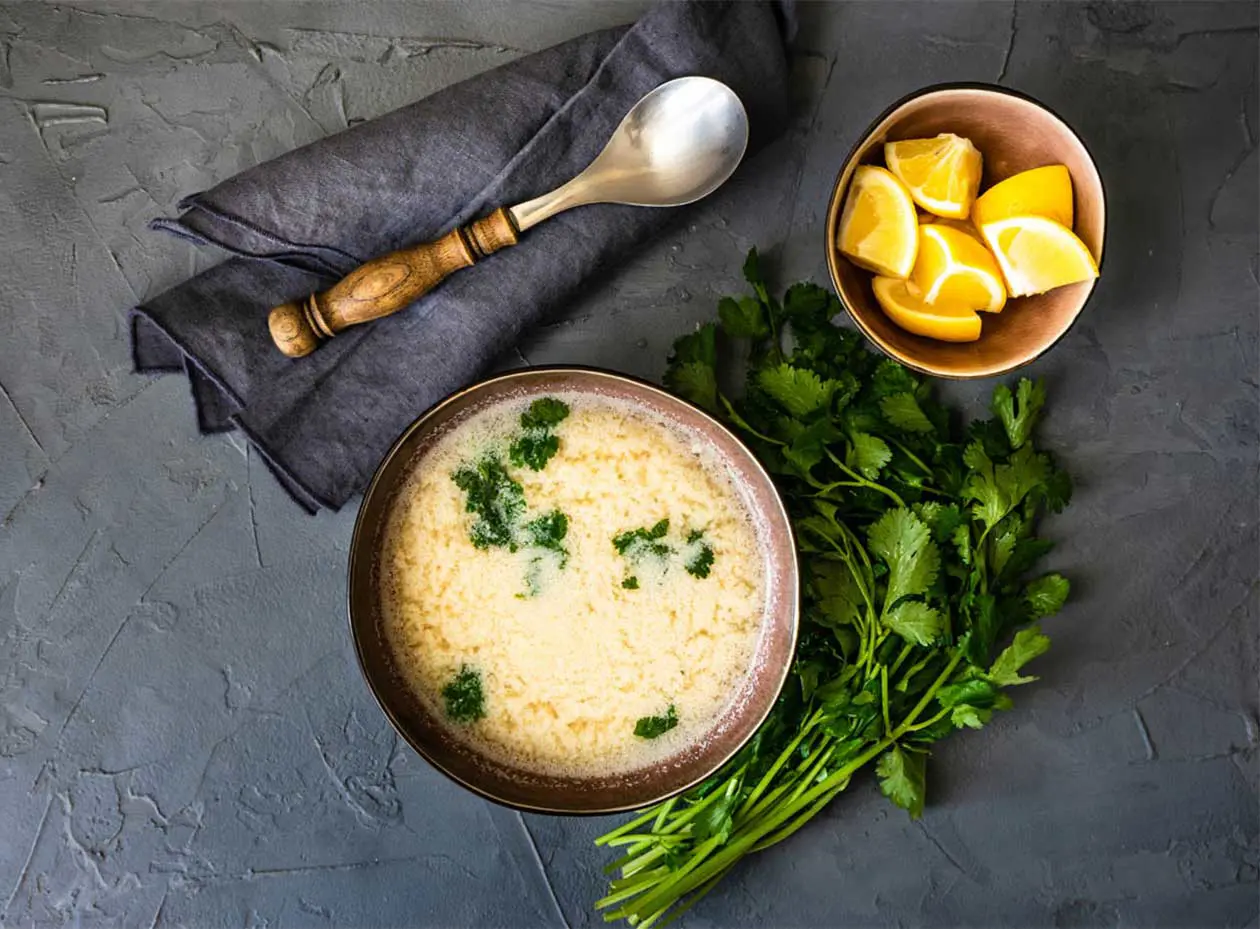
Chikhirtma Photo Copyright © Sisterscom.com / Depositphotos
Dishes are also accompanied by special sauces like Ajika (a spicy typical Georgian sauce rich in herbs and spices) and Tkemali, a sort of Georgian ketchup, red or green from sour Tkemali plums. It is also available in bottles, ideal to take home as a typical product and travel souvenir.

Churchkhela Photo Copyright © Sisterscom.com / Depositphotos
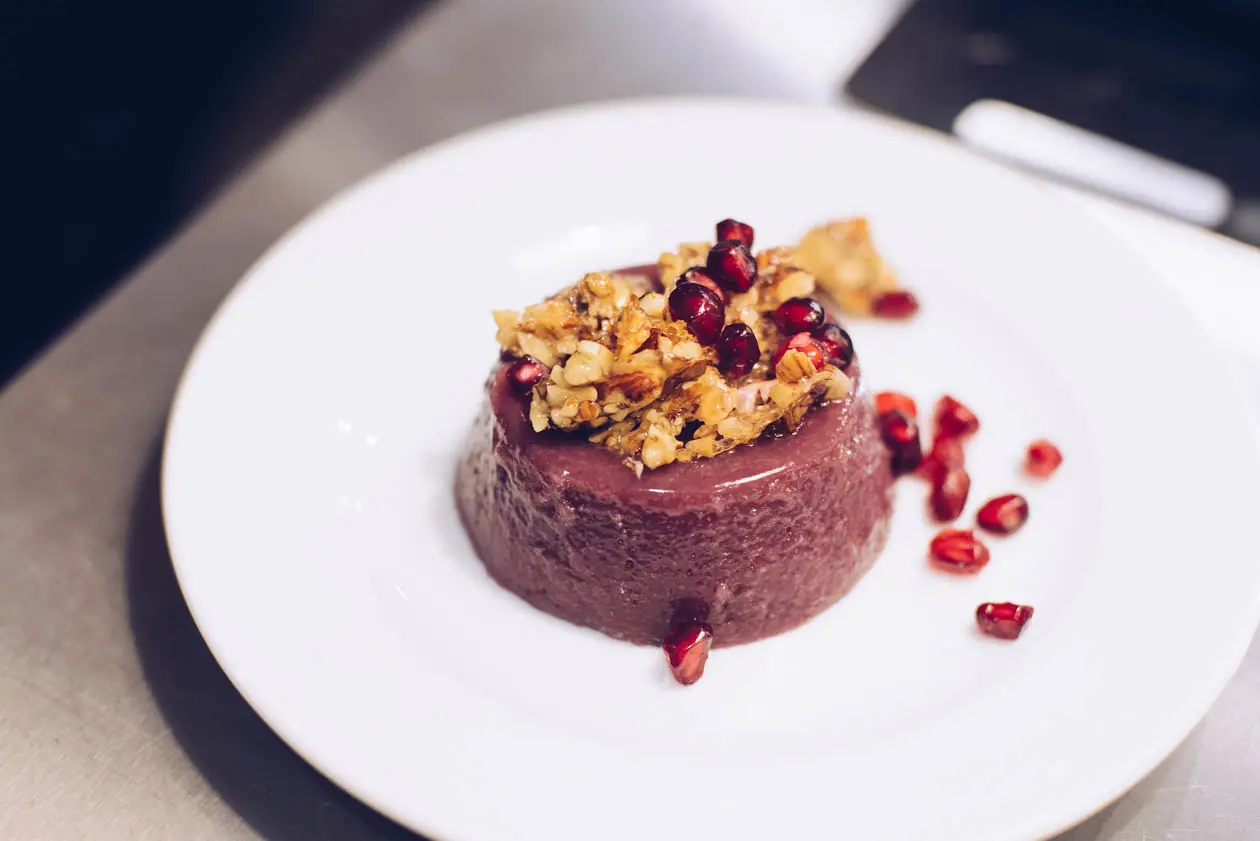
Pelamushi Photo Copyright © Sisterscom.com / Depositphotos
Desserts include traditional Churchkhela (nuts strung on a thread and dipped in a mixture of grape juice and flour, then hung to dry), Gozinaki (caramelized walnuts and hazelnuts with honey, a typical delicacy for Christmas and New Year), and Pelamushi (prepared with fruit, nuts, grape juice extract, sugar, and flour).
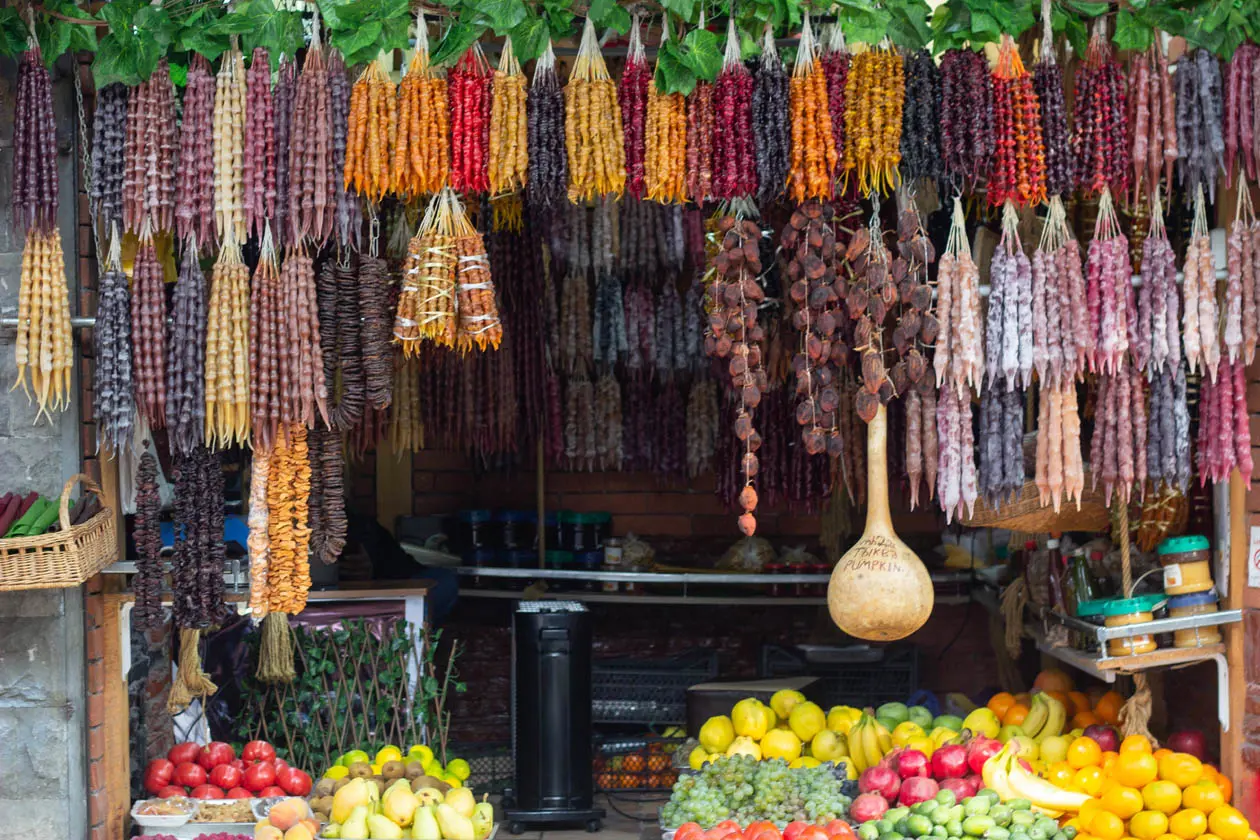
The markets of Tbilisi Photo Copyright © Sisterscom.com / Depositphotos
Tbilisi's markets, like the Dezerter Bazaar, are ideal for immersing oneself in the local atmosphere, offering spices, dried fruits, cheeses, herbs, and other typical products. When deciding where to eat, the choices are plentiful. The city of Tbilisi is dotted with venues of all kinds, from elegant restaurants that offer international menus alongside traditional cuisine, to traditional restaurants, wine bars, and pubs where one can taste traditional Georgian wines and local beers accompanied by tasty snacks.
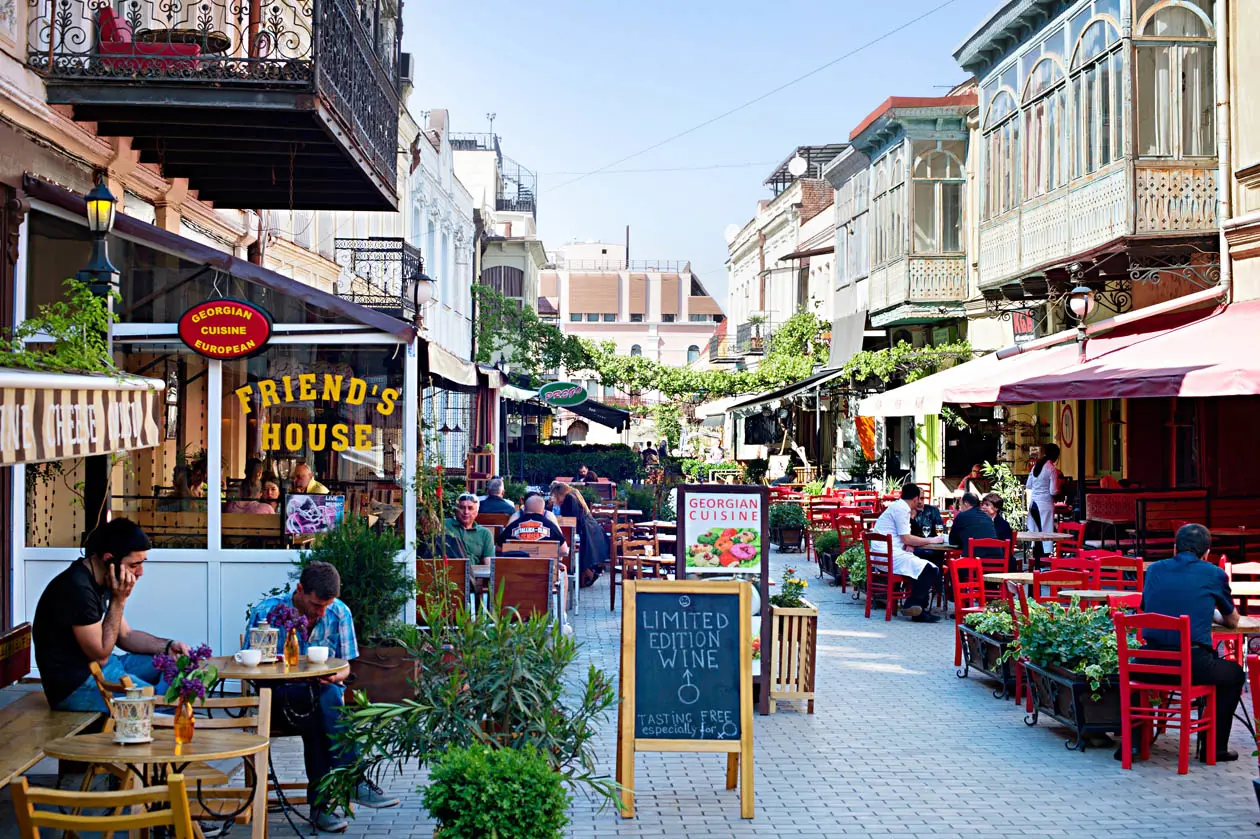
Tbilisi Copyright © Sisterscom.com / Depositphotos
In villages outside the city, more picturesque restaurants offer products and dishes from the tradition, making the enogastronomic experience truly enjoyable. In Tbilisi, the culinary experience always satisfies every palate, telling the story and culture of Georgia through unique and authentic flavors.
|
Tbilisi Photo: Copyright © Sisterscom.com / Depositphotos
Tbilisi is a city in the heart of the Caucasus, suspended between Europe and Asia not just in geographical terms but also from a cultural point of view, which welcomes visitors with its serene, friendly atmosphere, almost fairytale-like scenery of coloured wood houses with inlaid windows, old cobbled streets and health-giving spas.
|
|
Advertising
With Best Western Hotels & Resorts you can choose from over 4300 hotels in 100 countries. In Tbilisi you can stay in 2 facilities: the new Best Western Tbilisi City Center (located in one of the most prestigious districts of the enchanting Tbilisi-Vake and the historic center and main attractions are located a few steps from the hotel) and the BW Tbilisi Art Hotel which is located near the financial district of Tbilisi in the city center and offers excellent services at absolutely competitive prices.
|
Avion Tourism Magazine N79/2024 Special Edition for Milan Bergamo Airport
Issue closed by Editorial Staff on May 31, 2024
Editor in chief: Angela Trivigno. Contributors: Alisè Vitri, Enzo Cuppatri, Lisa Maria River, Nicole Villa. Cover photo: Copyright © Sisterscom.com Snc / Sean Pavone / Shutterstock.com. Photos: Copyright © Sisterscom.com Snc with image usage license purchased from Shutterstock.com and Depositphotos.com. Photo for editorial use only. Credits specified under each published photo or video. Press Offices and Tourism Board: visitcopenhagen.com; visit-hannover.com; germany.travel; rotterdam.info; turismoasturias.es; gnta.ge; Elie Saab; John Richmond; Issey Miyake; Philipp Plein; Shiseido; Zadig&Voltaire; AJet; Lumiwings; Sacbo S.p.A.. Avion Tourism Magazine Special Edition for Milan Bergamo Airport N.79/2024: issue closed by Editorial Staff on 31/05/2024 and published on www.aviontourism.com Registration: Registered at Bergamo Law Court Bergamo N.1 del 09/01/2003 and N.9/2019 del 03/07/2019. Periodicity: semiannual. Publisher, Editing, Administration and Advertising: Sisterscom.com Snc - Via Piave, 102 - 23879 Verderio (Lc) - Italy. P.Iva/C.F. 03248170163 - Registro delle Imprese di Lecco Numero LC-304260. Literary and artistic property: Copyright © Sisterscom.com Snc. All rights reserved. Reproduction prohibited in any form and medium.

 You're browsing offline! External links will become available when you're online
You're browsing offline! External links will become available when you're online

